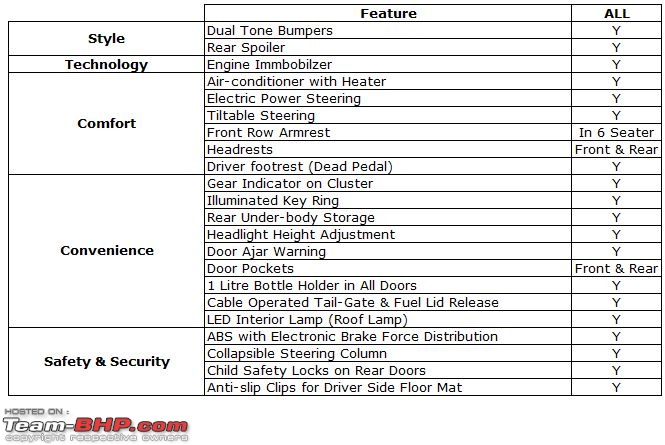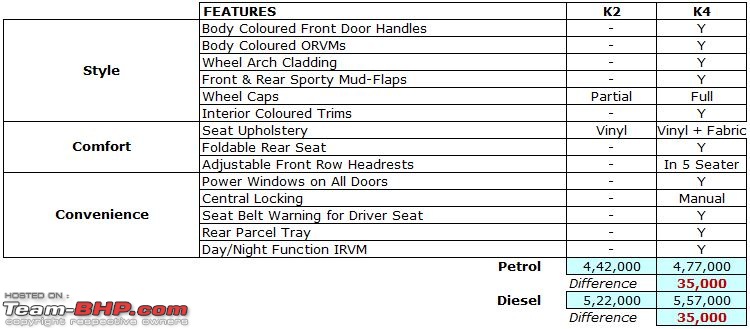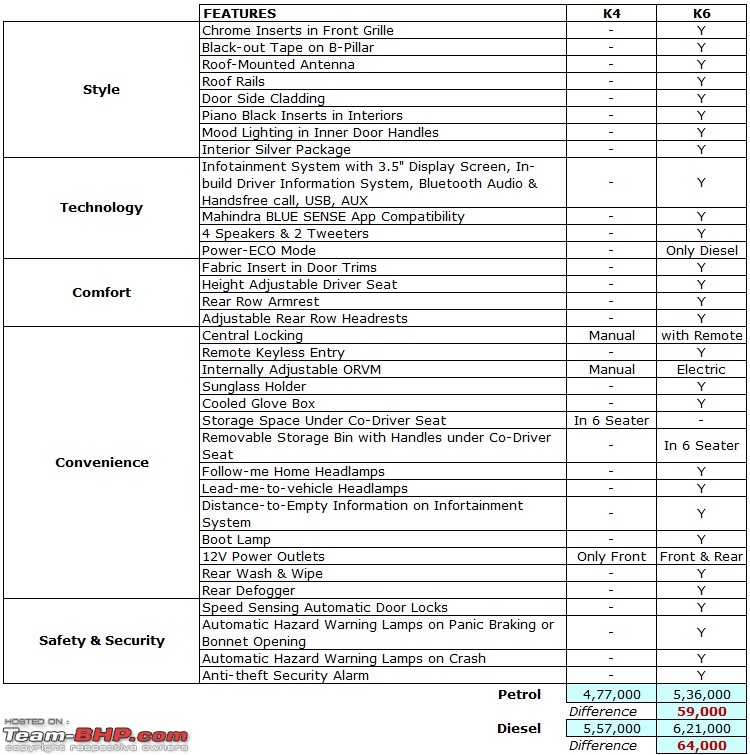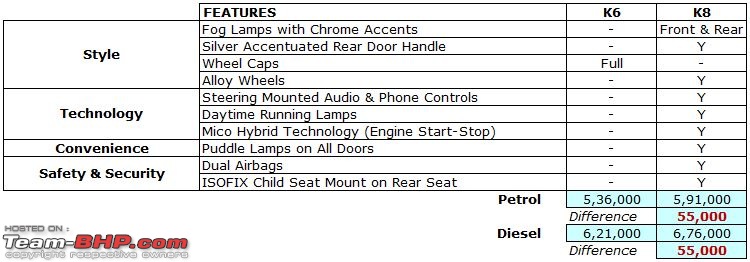| |||||||
| Search Forums |
| Advanced Search |
| Go to Page... |
 |
| Search this Thread |  511,086 views |
| | #1 |
| Team-BHP Support  | Mahindra KUV100 : Official Review The Mahindra KUV100 has been launched in India at a price of between Rs. 4.45 - 6.84 lakhs (ex-Delhi). What you'll like: • An SUV'ish hatchback! A unique offering in many ways • Likeable cabin. Good interior space for a car with such a small footprint. Lots of storage too • Both engines are city-friendly, while the gearshift quality is simply superb! • Urban / low speed ride quality is compliant • ABS standard across the range. Dual Airbags optional on all variants  • The features: DRLs, ambient lighting, power & eco modes (diesel), Blue Sense App, front armrest, cooled glovebox, Isofix child seat mounts etc. What you won't: • Overdone styling! The side profile, in particular, is weird • Handling, NVH & braking are all poor at 100+ kph. Engines also lack punch on the highway • Electric steering is horribly calibrated. Very vague, with inconsistent weight at speed • It's not a 6-seater. That seating position is cramped & unsafe • Useable space in the boot is much lesser than its on-paper spec would have you believe • Mahindra’s after sales service is a hit or miss 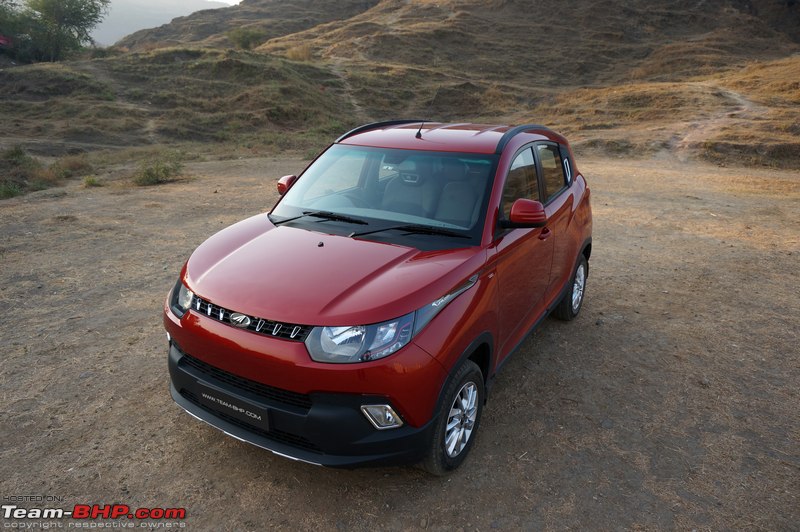 Last edited by GTO : 7th March 2016 at 21:56. |
| |  (37)
Thanks (37)
Thanks
|
| The following 37 BHPians Thank Aditya for this useful post: | Aficionados, amit_purohit20, anilntny, ashpalio, Ashtoncastelino, AutoIndian, BlackPearl, engine_charan, fusionbang, GTO, hemanth.anand, hmansari, jeetaman, MaheshY1, mallumowgli, manij, MDED, Mi10, mrbaddy, noopster, pankajn1702, parsh, peterjim13, Ponbaarathi, PrasunBannerjee, Rajeevraj, RavenAvi, RSR, sandeepmohan, scopriobharath, SDP, swiftnfurious, Technocrat, theexperthand, Tushar, vibbs, Vik0728 |
| |
| | #2 |
| Team-BHP Support  | 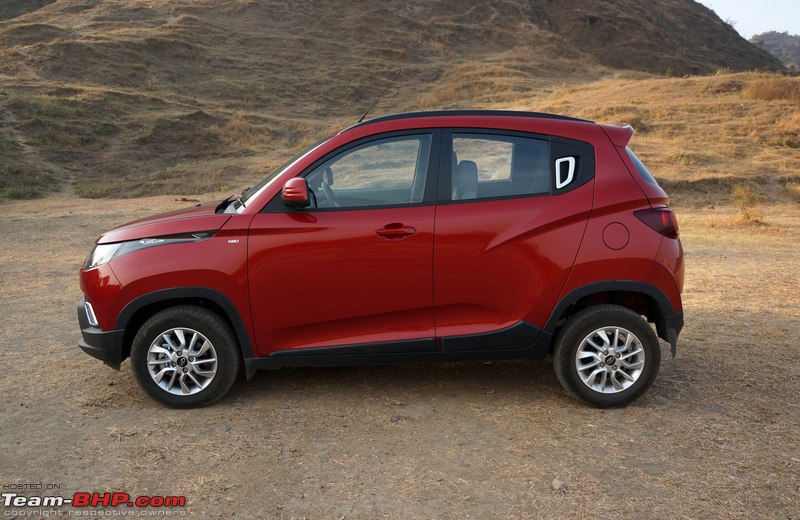 Mahindra is a name synonymous with utility vehicles. The company’s best-selling products are the Bolero, Scorpio, TUV300 and XUV500. Impressively, most of these UVs outsell their rivals by a large margin. On the flip side, Mahindra tried its hand at marketing a sedan (Verito) and a confused product (Verito Vibe), but both flopped miserably. The company has not given up. It has decided to move out of its comfort zone and enter the highly competitive hatchback segment with the KUV100. Why is Mahindra pushing the KUV100 as an SUV? Simply because, if it was a standard-fare hatchback, it would've sunk without a trace (see what happened to the Bolt). Maruti & Hyundai fiercely guard their turf & fight hard on each sale. That's why the KUV100 is 'different'. The overdone styling? Same reason. It might put off some, yet the design has great appeal among Mahindra fans from smaller towns as we found out on our highway drive. The SUV positioning is synonymous with the Mahindra brand. The management hopes to get the patronage of its present customers. 6-seater variant? You guessed it - to differentiate the KUV100 from the likes of the Swift & Grand i10. But make no mistake, the KUV100 is a hatchback, not an SUV. Mahindra needed to target this segment for growth as it's pretty much got the UV segments covered. Where will additional market-share come from? Hatchbacks dominate India's automotive scene. In 2015, 50% of all cars sold in the country were hatchbacks (related thread). This is more than double the volume of the next best-selling segment - sedans. Cars such as the Maruti Alto, Swift, Wagon R, Celerio, Hyundai Elite i20 and Grand i10 feature on the list of top 10 best-selling models. 2016 is likely to see even more hatchbacks (Maruti Baleno and Renault Kwid) muscling their way into the list. 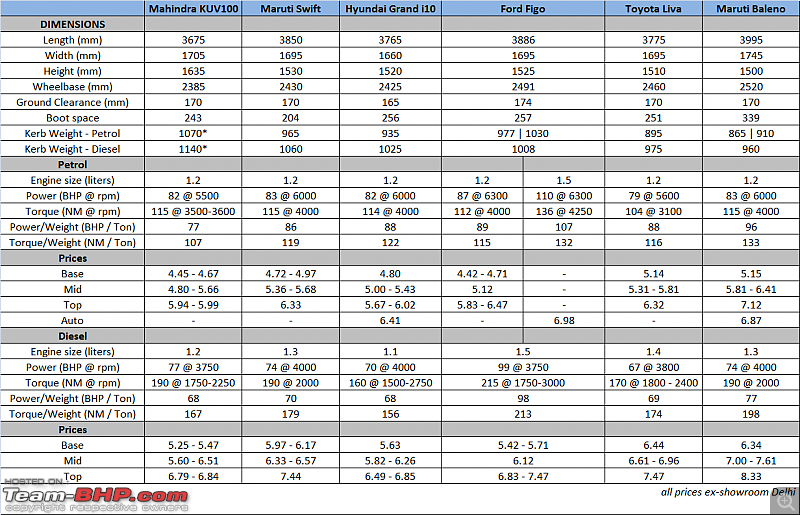 The KUV100 already has over 20,000 confirmed bookings & the company plans to scale up production to 8,000 odd cars / month (currently 5,000 odd). Because it's locking horns with the big guys, as a differentiator, ABS is standard and dual front airbags + an extra seat are offered on every variant. The company has also priced it slightly lower than the main competitors. The KUV100 (KUV stands for Kool Utility Vehicle  ) has been designed and engineered at the Mahindra Research Valley, Chennai. The project was codenamed S101 and test mules have been running around since March 2013. We were the first to show you pics without camo (link to news). Mahindra is manufacturing the car at its factory in Chakan, Maharashtra. ) has been designed and engineered at the Mahindra Research Valley, Chennai. The project was codenamed S101 and test mules have been running around since March 2013. We were the first to show you pics without camo (link to news). Mahindra is manufacturing the car at its factory in Chakan, Maharashtra.While Mahindra's bread & butter products are body-on-frame UVs, this is a FWD monocoque with a transverse engine layout (standard-fare for the hatchback segment). It is the company's second monocoque car after the XUV500 (Verito was designed by Renault). The KUV100 measures 3,675 mm in length, 1,705 mm in width (1,715 mm with door cladding) and 1,635 mm in height (1,655 with roof rails). It has a wheelbase of 2,385 mm and ground clearance of 170 mm. While this makes it the tallest car in the B2 segment, it is also the shortest (in terms of length). Like some of its siblings, the KUV100's styling can be described as quirky and definitely OVERDONE. The design appears to have bits of many cars mashed into one. While the front & rear views are acceptable (albeit, still overdone), the side profile is awful! The vehicle has a high stance, while the dual tone bumpers, a silver skid plate at the front, black plastic cladding along its sides, beefed up wheel arches and roof rails make it look SUV'ish. At the front, there is a sculpted bonnet, a thin grille with chrome inserts and wraparound headlamps with LED DRLs. The bumper houses a large air dam and vertically-placed foglamps with chrome bezels. Viewed head-on, the KUV100 does have some presence. It’s when the car is viewed from the sides that things tumble downhill. To start with, the KUV100 rides on 14" wheels which are way too small for the height of car. Then, the cuts & creases are simply excessive. The wheel arches are prominent and there are strong character lines that don't appear to be in sync with each other. Transparent plastic strips on the front panels merge into the headlamps, giving the impression that the headlamps sweep back almost all the way to the A-pillar! The strip on the right bears the letters 'KUV100', while that on the left comes with "Powered by mFalcon" lettering. These strips end with a turn indicator. The door mirrors sport a unique "clenched fist" design pattern. While the front door handles are conventional, the vertical ones at the rear are located higher up, much like the Chevrolet Beat. Additionally, the roofline of the car slopes down towards the rear making the rear windows pretty small. The car has very short overhangs, with bumpers that don't stick out. What is surprising is that, even if Mahindra wanted to keep the length of the car under 4 meters to make it eligible for excise duty benefits, it had another 324 mm to play with. The additional length would have given the KUV100 a more proportionate appearance. At the rear, the KUV100 has a pair of double barrel tail-lamp clusters, a roof mounted spoiler and a dual tone bumper (black bottom) with two foglamps + chrome bezels. The strong character lines that start on the rear doors and run across the rear panels continue on the hatch, just above the tail-lamp clusters. Give Mahindra's designers a geometry box and they sure know how to play with it! I must reiterate this - while the KUV100 might seem overstyled to tier 1 city dwellers, it's a big hit in smaller cities and towns. Most of the people I spoke to in such places absolutely loved the way the vehicle looked. In that sense, the overdone design does help to favourably differentiate the KUV100 from its Japanese & Korean competition. Lastly, though still quirky, the KUV100 does look better in person (vis a vis pictures). The paint quality is decent, but can't match the lustrous Tata Bolt. At some places, the finish could have been better. Look closely and you'll spot some rough edges here & there. While overall quality is acceptable at this price point, it's certainly not 'Grand i10' good. Mahindra still has a long way to go before its cars can compete with Hyundais in this regard. The build quality is also not up to the mark. The rear right door rattled every time we slammed it shut. The bonnet is quite heavy, but the tail gate feels rather light. The doors are somewhere in between (nope, no thud). The fuel flap doesn't feel well-damped and rattled on our test car. Squeaks & rattles are simply unacceptable on a brand new car! Mahindra isn't sharing the kerb weight, but BHPian drjkonline reported the diesel's weight at 1,140 kilos (from his registration documents). Based on the GVW difference, we can safely assume the petrol's kerb weight to be 1,070 kilos. Both of these figures are higher than the direct competition, which is especially surprising as the KUV100 has a smaller footprint & 3-cylinder engines. 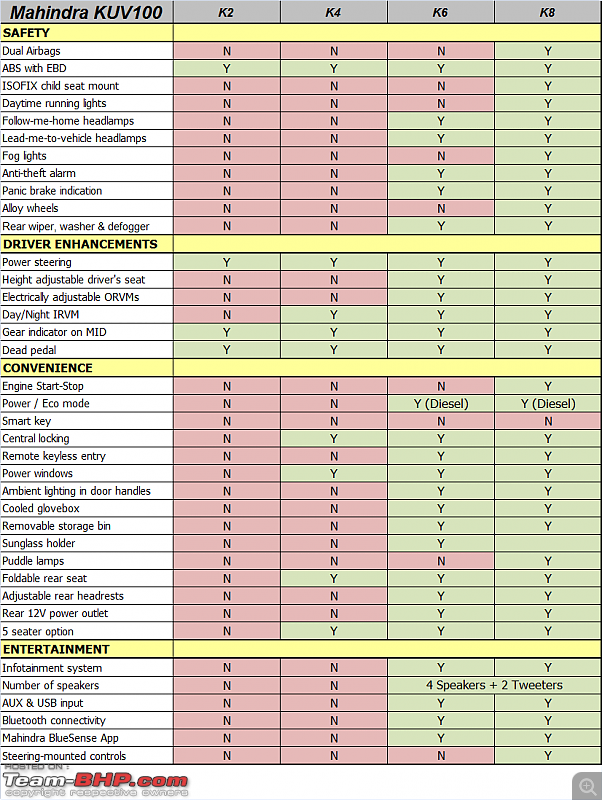 Loaded front end gives it good presence by hatchback standards. The slim grille and wide air dam could have been inspired by the Ford EcoSport (reference image). There's also some resemblance to the Evoque here: 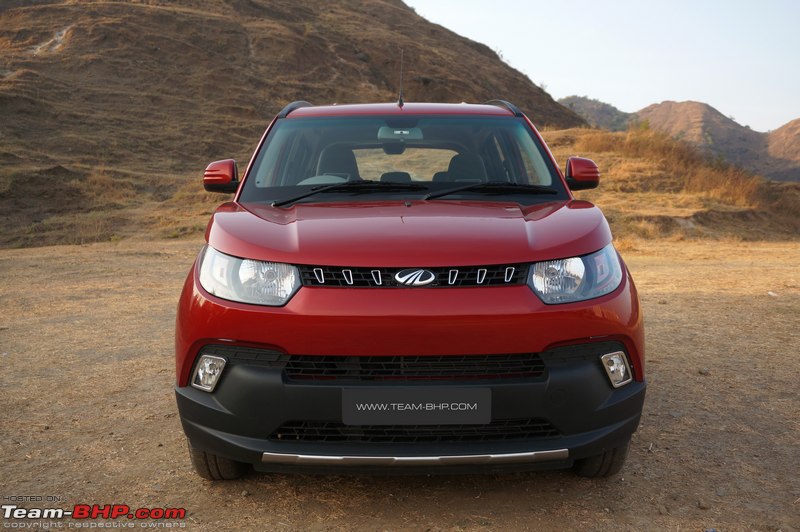 Rear has a more hatchback-like appearance. Still overdone: 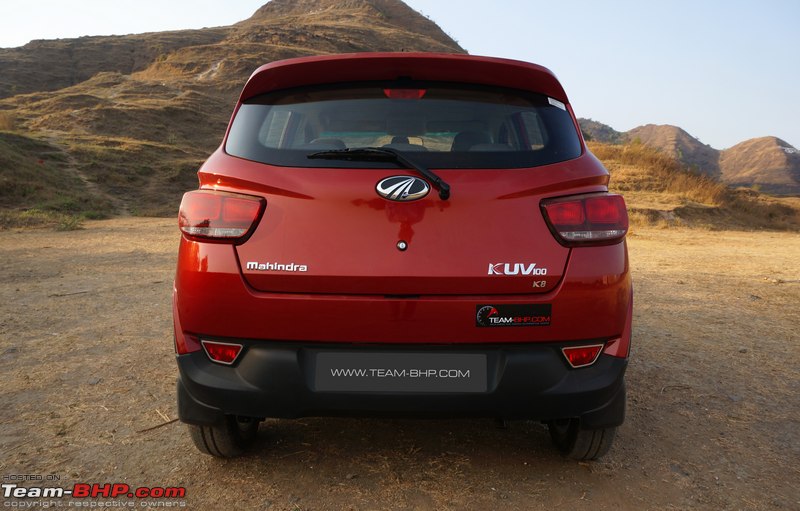 Goodness, the KUV100 is over-styled & how! Prominent wheel arches, excessive creases and character lines that seem out of sync with each other give the impression that Mahindra's designers were trying too hard. The car might look less offensive in black colour. 14" rims look too small for all that metal on top: 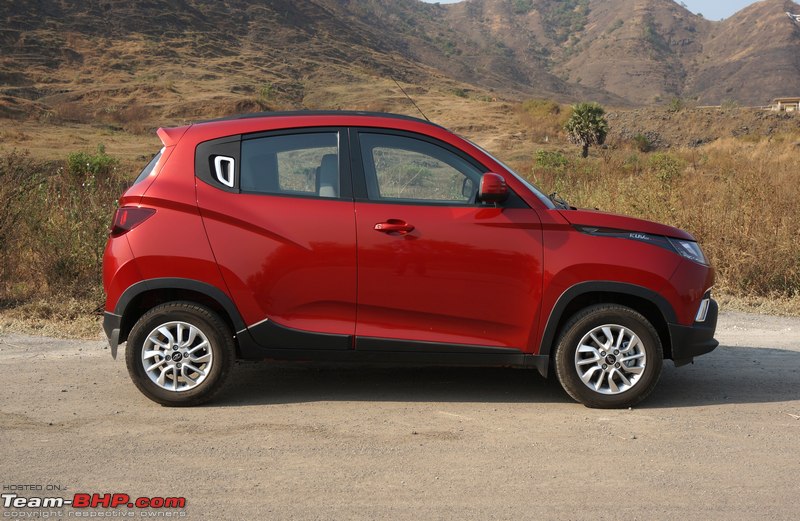 The KUV100 stands 3,675 mm long, 1,705 mm wide (1,715 mm with door cladding) and 1,635 mm high (1,655 with roof rails). Wheelbase = 2,385 mm: 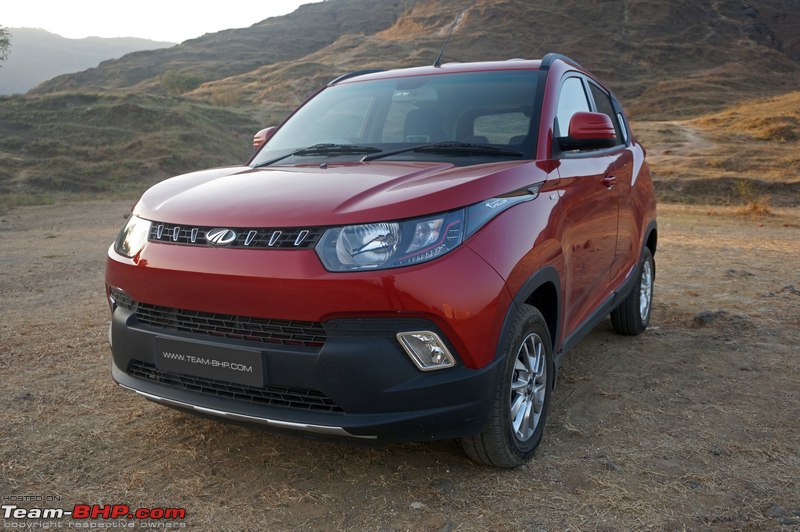 We find the design gawdy, but a lot of folk in smaller towns loved it. Roof rails and black plastic cladding slapped on for the SUV effect: 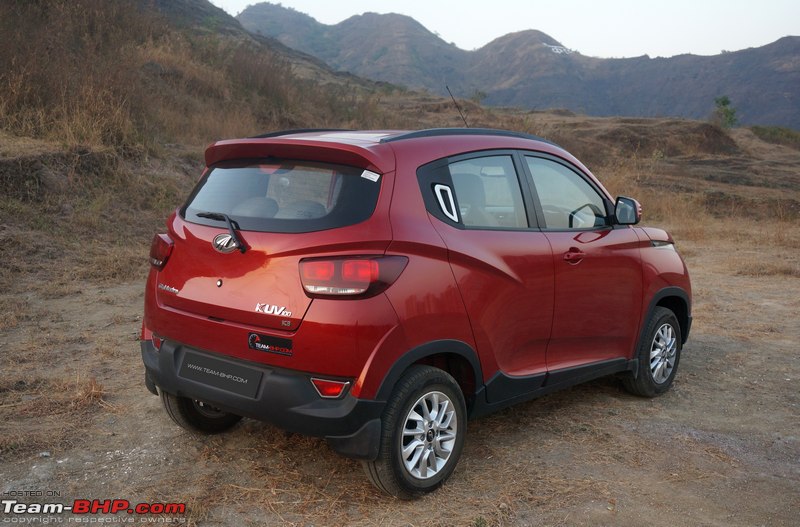 Headlamp cluster consists of halogens, turn indicators and LED DRLs. While the actual headlamps aren't very large, plastic strips on the sides give the impression that they stretch back a long way. Mahindra compares them to sunglasses: 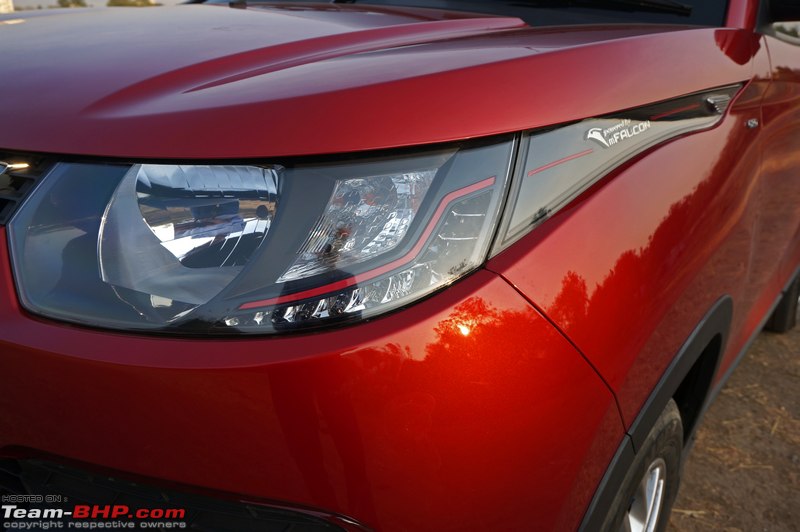 Notice the S-shaped red line inside. Turn indicators have unique detailing. Hazard lamps automatically come on when bonnet is open or if the vehicle meets with an accident: 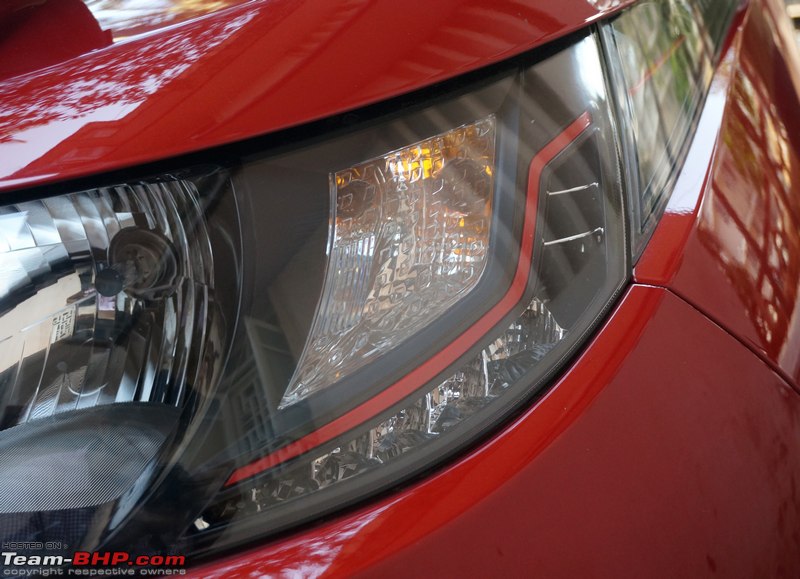 With the DRLs on - they are on by default. Switching on the pilot lamps makes them dim a little. On unlocking the car, the DRLs blink thrice: 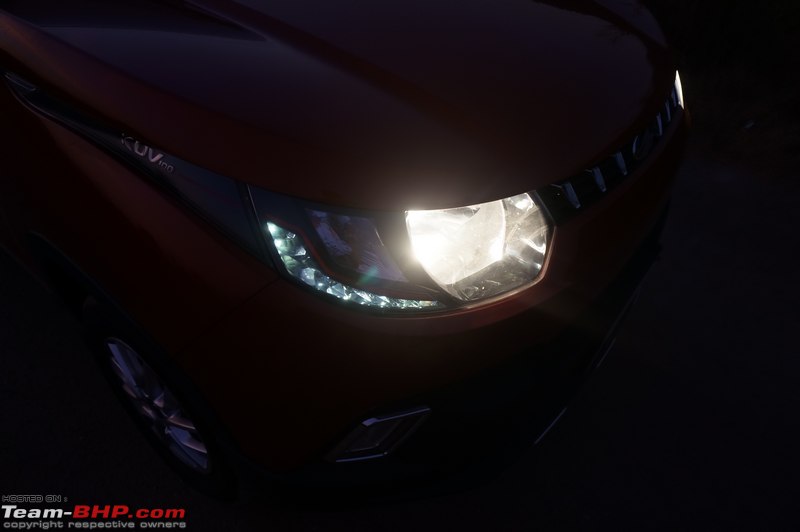 Image showing all the lights in the headlamp cluster. When you press the lock button twice after switching off the car, the follow-me-home function is activated and the headlamps stay on for 20 seconds. Similarly, press the unlock button twice and the guide-me-to-vehicle function is activated in the same way: 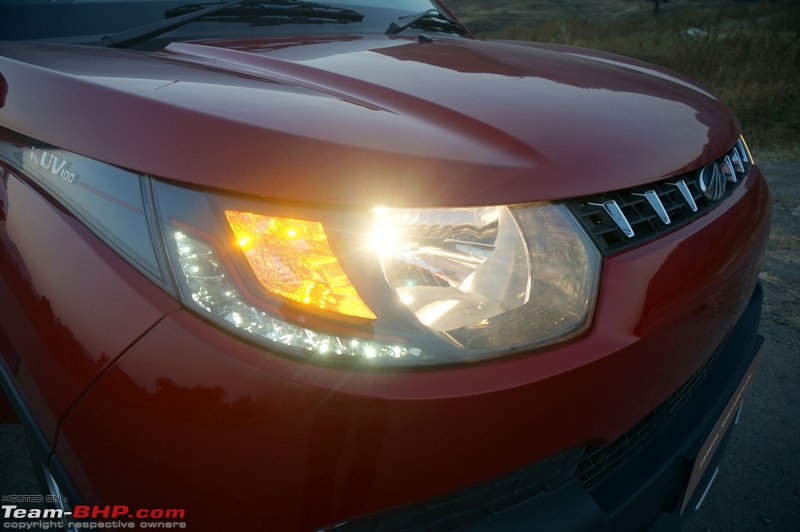 L-shaped DRLs are bright & prominent during the day: 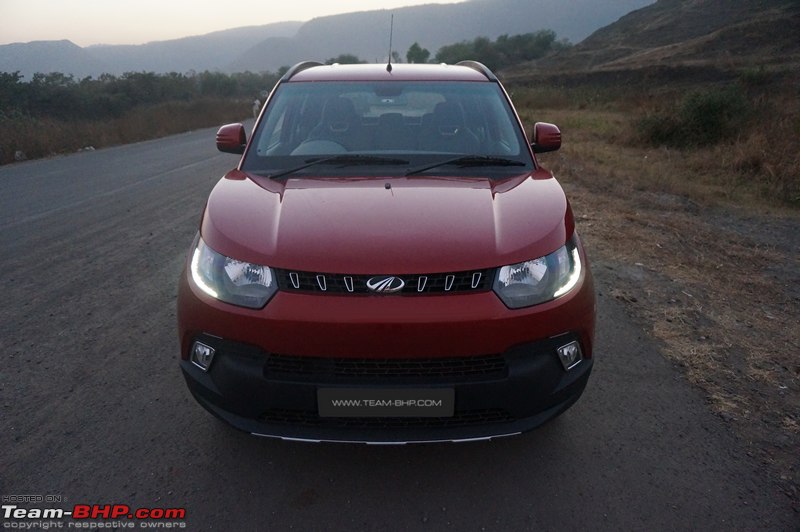 Slim black grille with a Mahindra badge in the middle. Claw-like chrome inserts are becoming a Mahindra design trait: 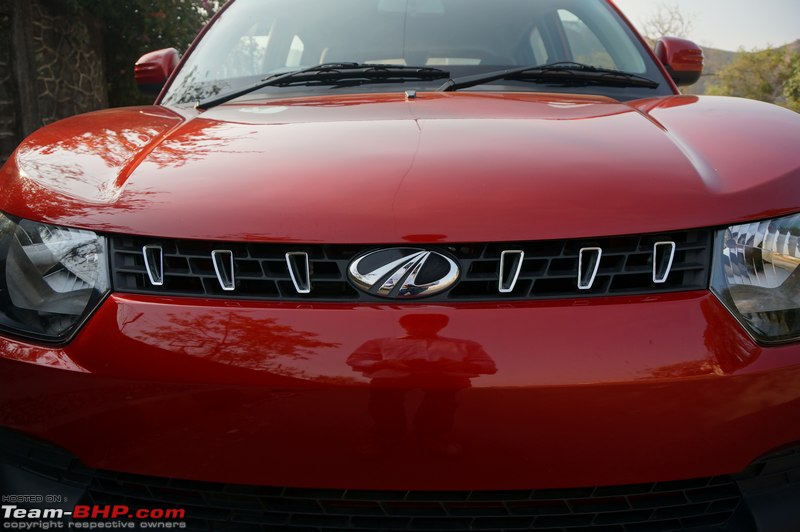 Dual-tone bumper has a black bottom. It houses a large air dam, much like the Ford EcoSport. The mesh design pattern is carried over from the grille: 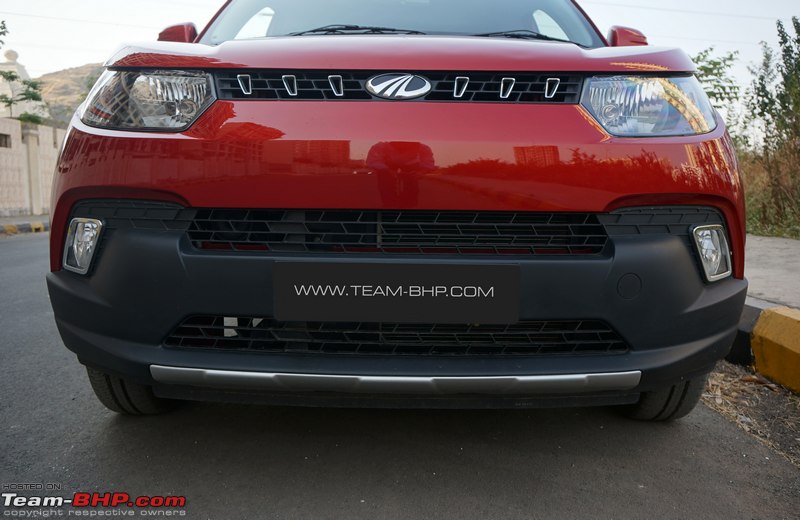 Plastic skid plate for that SUV touch! Obviously, it's not functional: 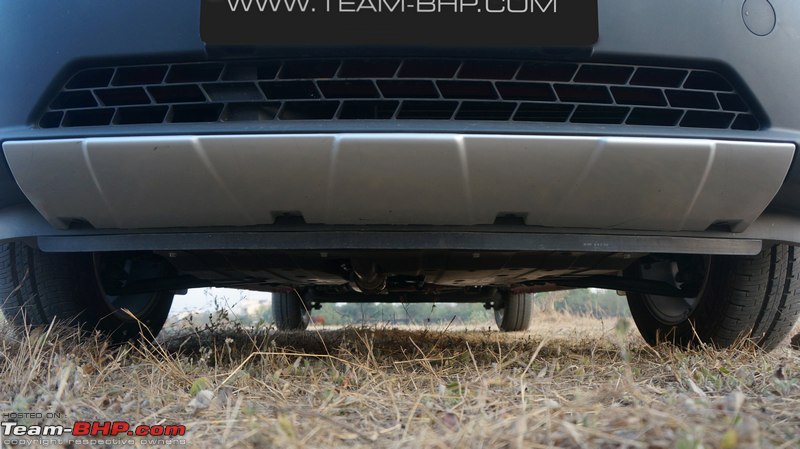 Vertically-arranged foglamps with chrome outlines: 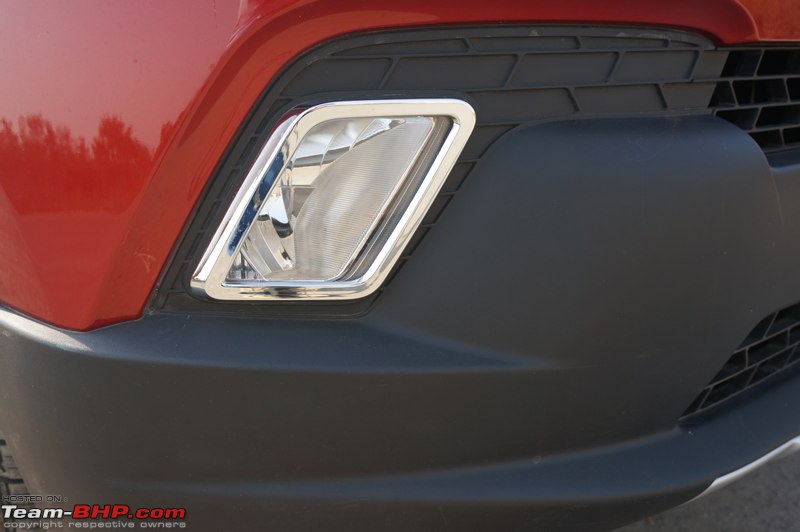 Tow-hook cap has an arrow indicating where you should press to remove it: 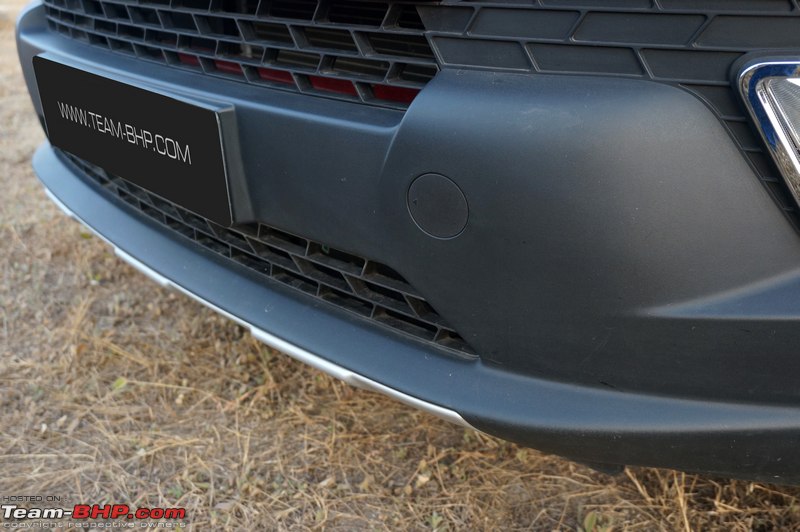 Single windshield washer shoots out water through three nozzles. Should've been hidden under the bonnet: 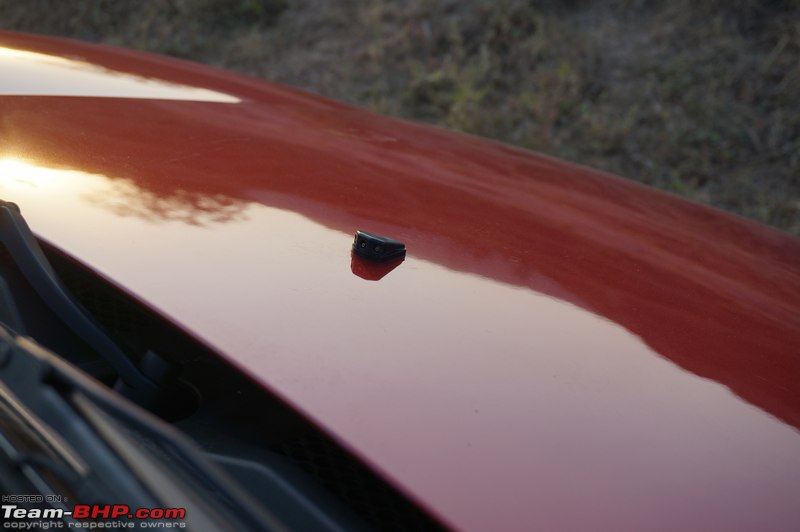 KUV100 lettering on the right plastic strip: 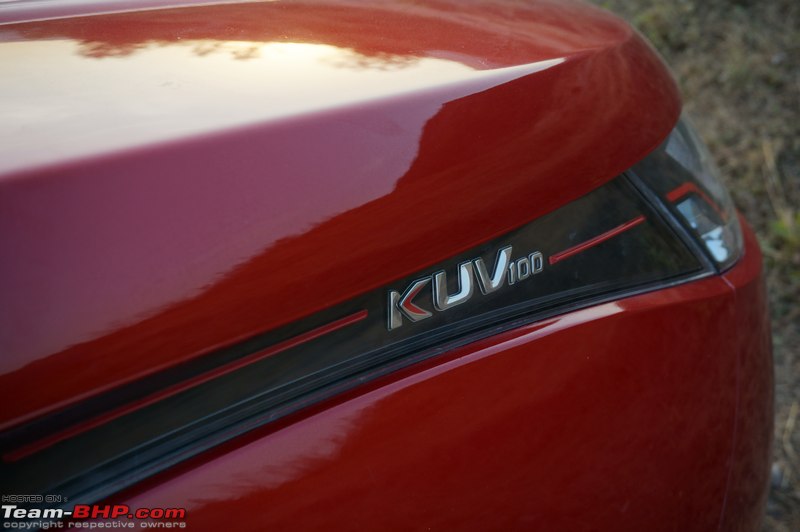 Turn indicator is located at the end of the plastic strip: 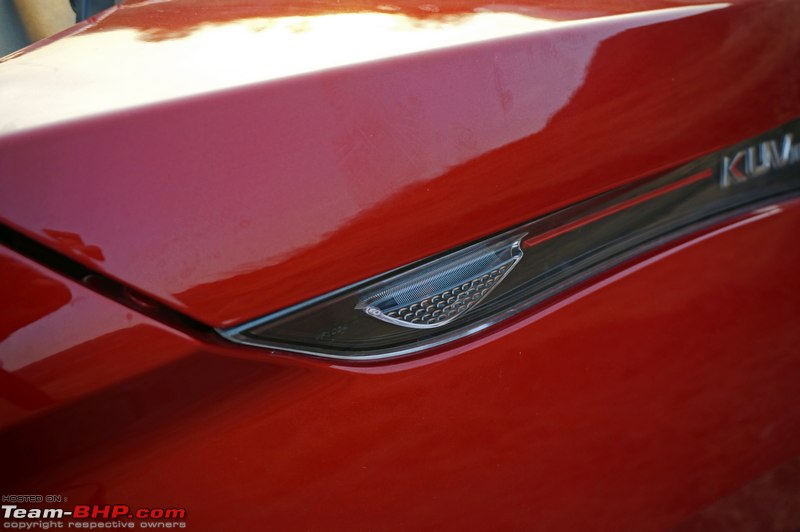 Lettering on the left denotes the engine family: 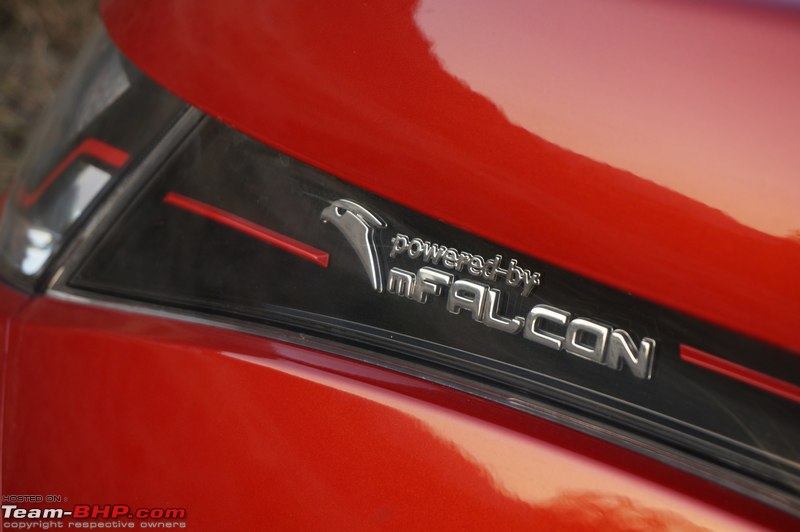 Engine code on the left fender is the only indicator of the fuel type (G80 = petrol, D75 = diesel): 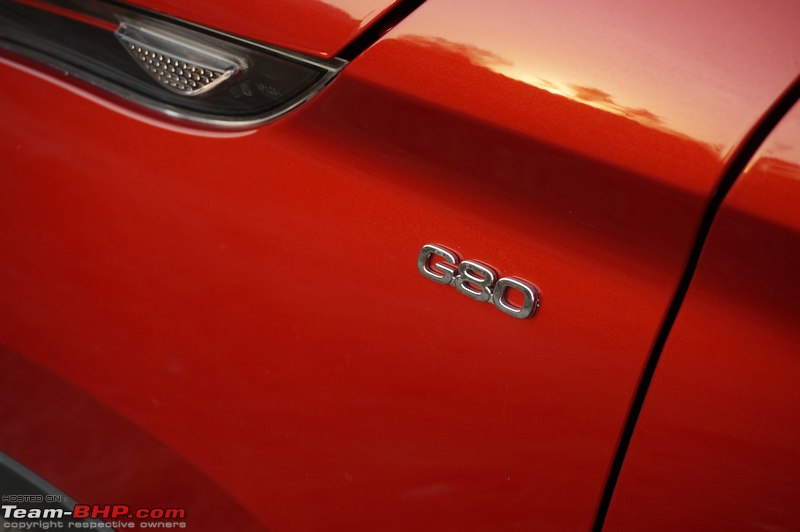 Unique detailing on the ORVM. Mahindra calls it the "clenched fist" design  . I couldn't fold them the other way (almost reached the breaking point), so cannot comment whether they can take hits from bikers: . I couldn't fold them the other way (almost reached the breaking point), so cannot comment whether they can take hits from bikers: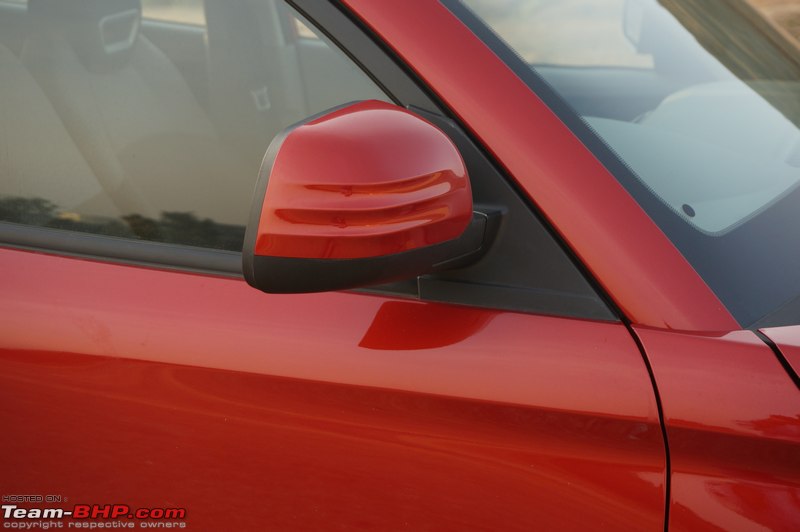 Simple body-coloured front door handle: 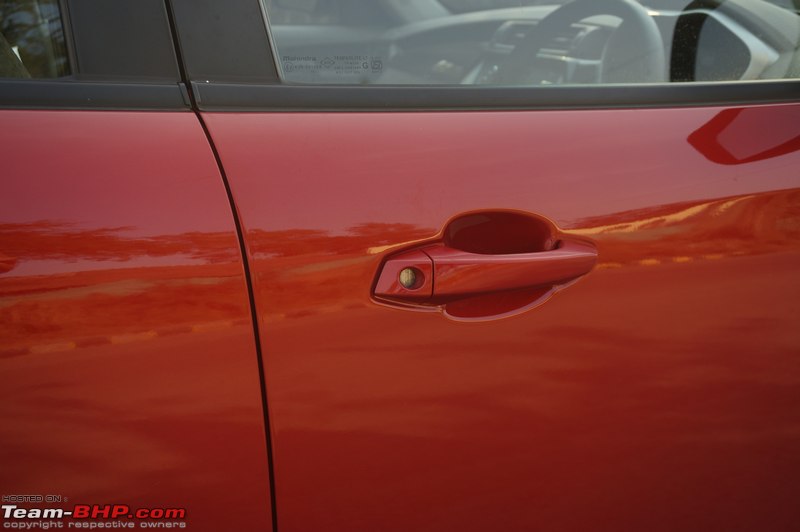 14" spider-design alloy wheels only on the K8 trim level. They are shod with 185/65 section tyres. The wheels look damn small on this car: 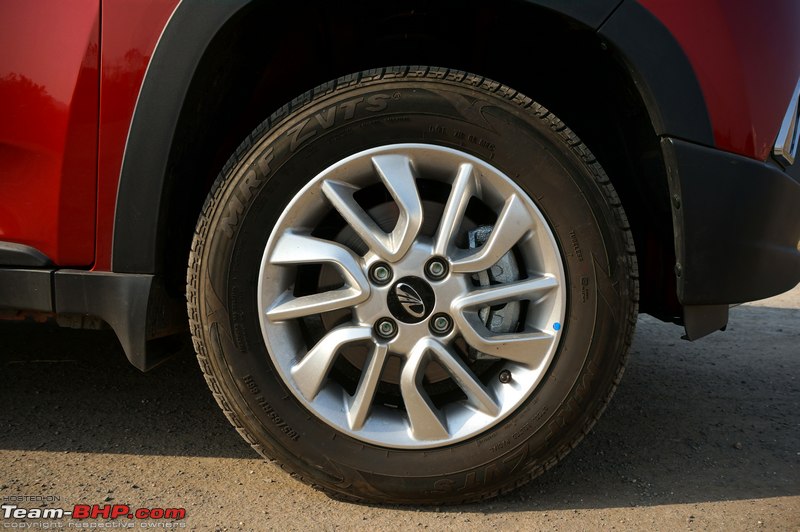 Wheel arches are prominent. Thin black plastic cladding around their edges too: 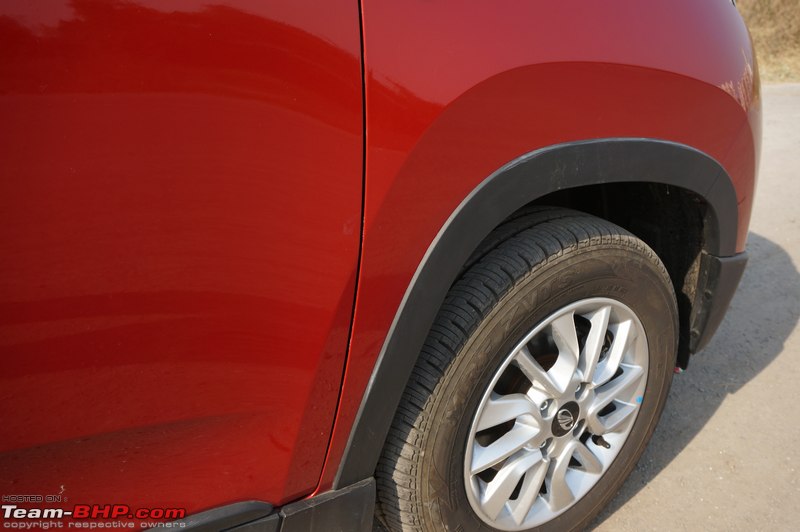 Plastic cladding runs across the car. In this image, check out the prominent crease on the doors: 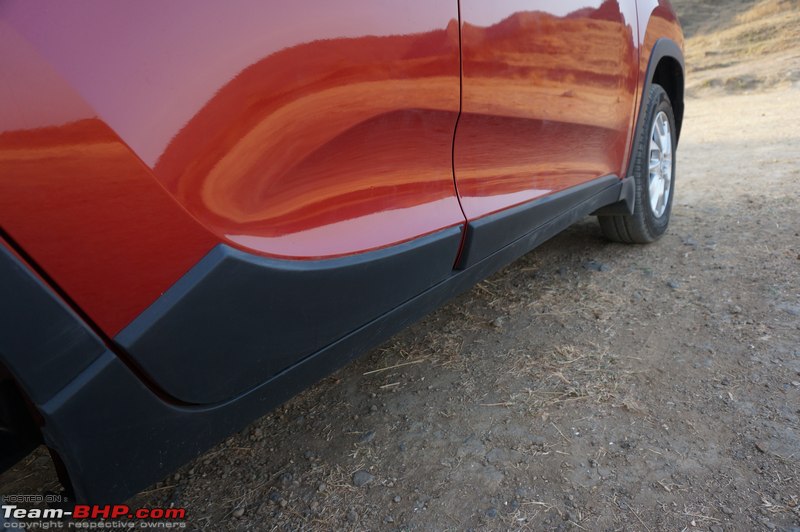 Cladding extends all the way down to the frame of the KUV100: 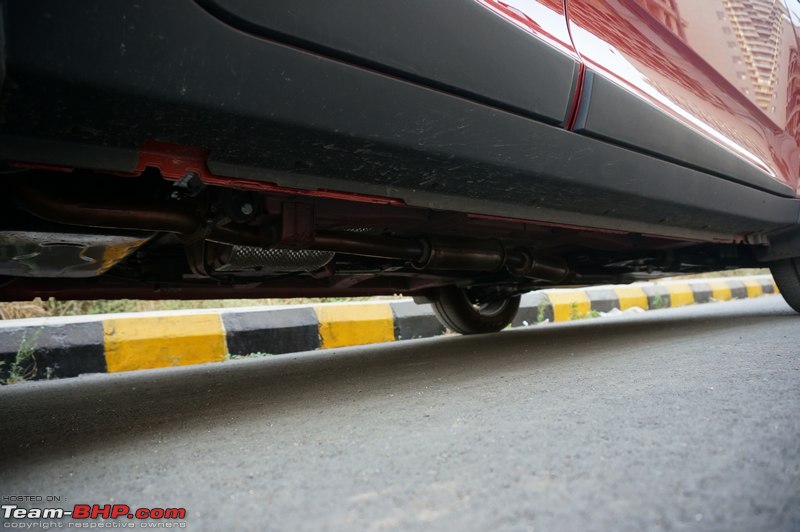 Blackened window panes & B-Pillar. Roofline tapers towards the rear. That, along with the black plastic panel (on which the rear door handle is mounted) reduces the glass area at the back: 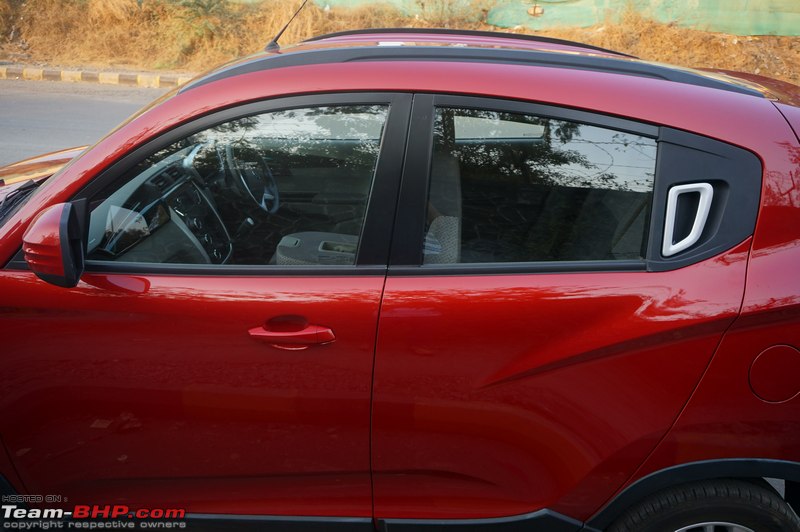 Funky rear door handle, much like the Chevrolet Beat: 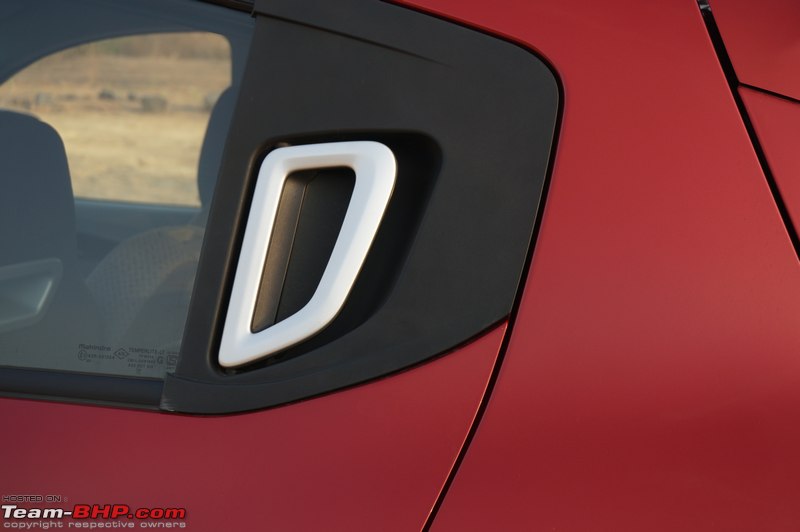 KUV100 gets a ribbed roof for added rigidity. Roof rails aren't tightly attached - they were shaking as I held them: 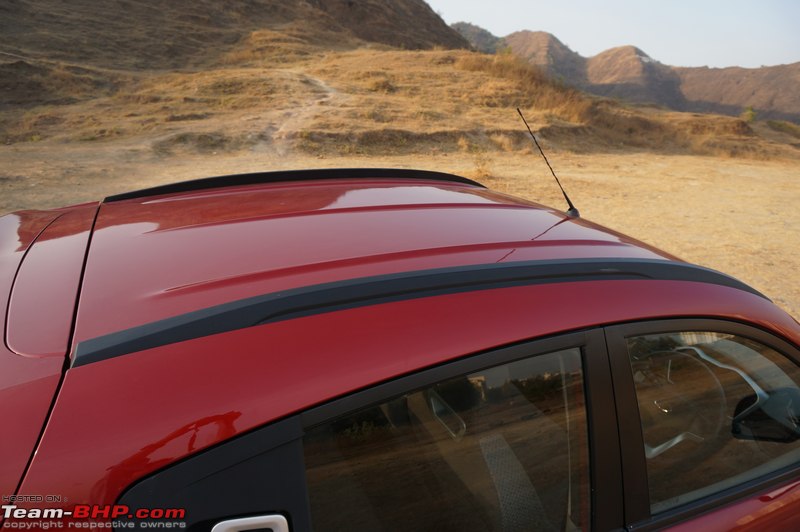 Radio antenna sits at the front of the car: 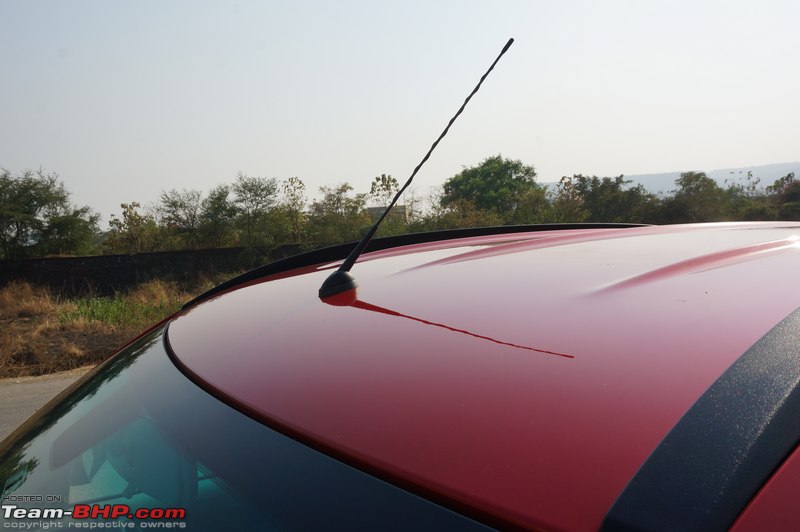 Rear bumper does not stick out at all, which means that any hit will be taken by the body. Don't understand why. Mahindra could have extended it out and still kept the car under 4 meters: 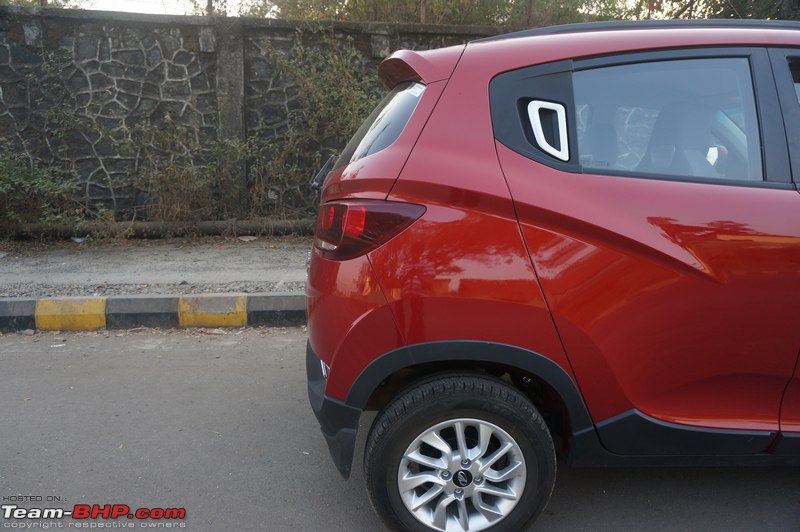 Notice how the character line starts on the rear door and ends on the hatch: 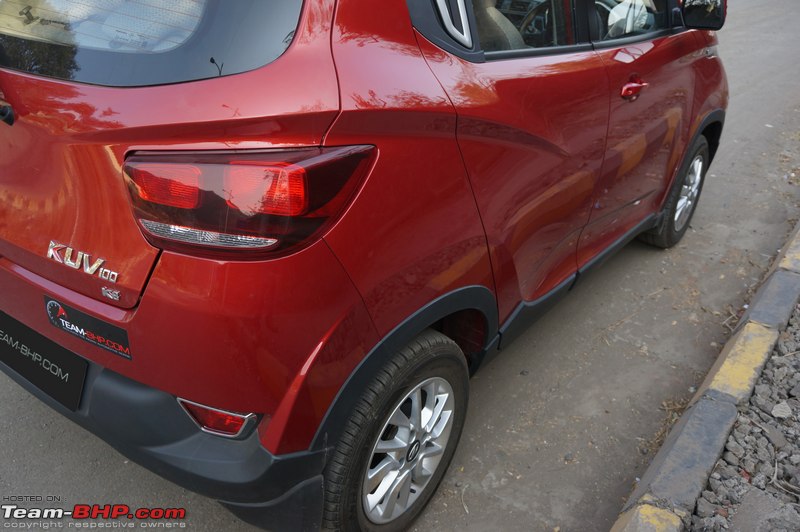 Double barrel tail-lamps with strips for the reversing & turning lights: 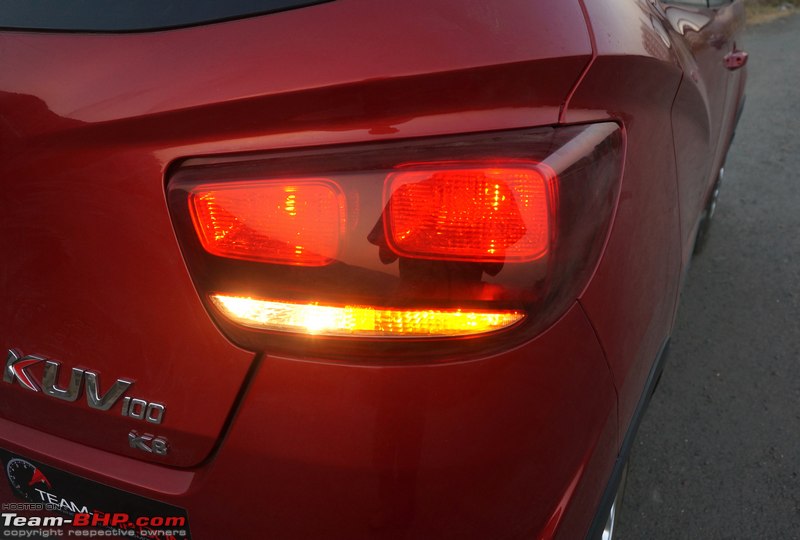 Outer barrel lights up when the brakes are applied: 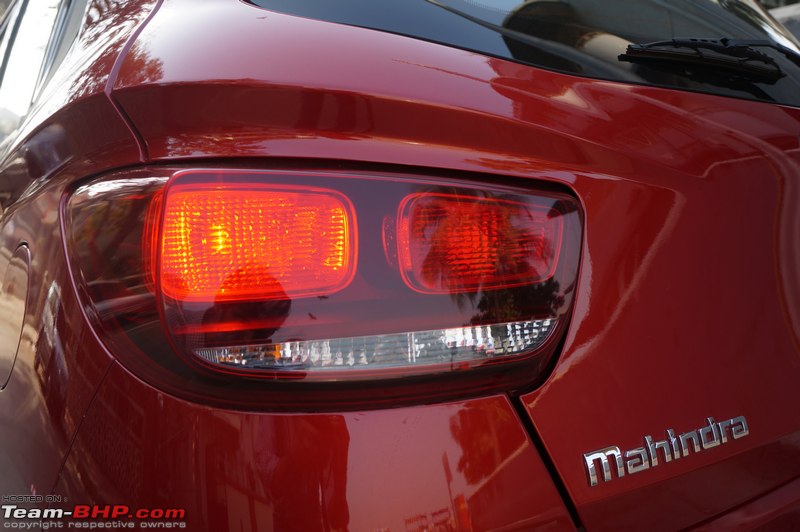 Roof-mounted spoiler is well integrated into the hatch. The windshield washer is concealed in it. I wish the HMSL was housed on the spoiler itself: 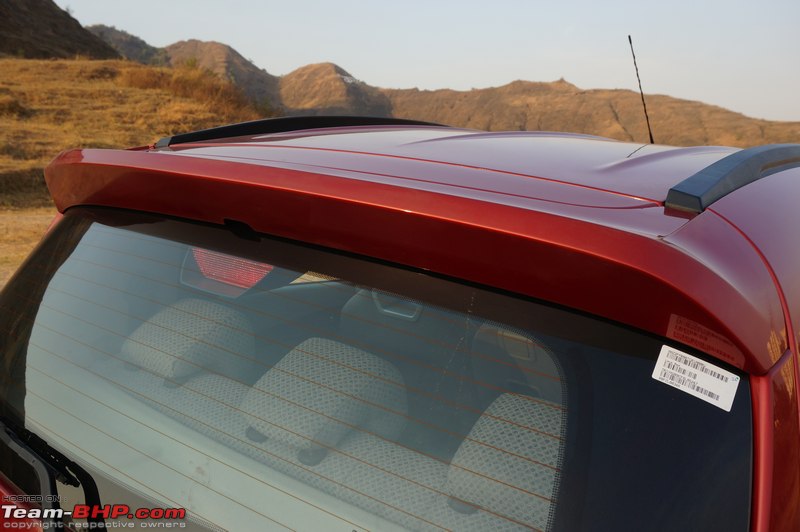 Large, old-fashioned wiper sticks out of the tail gate, rather than being on the rear windshield like in most modern cars: 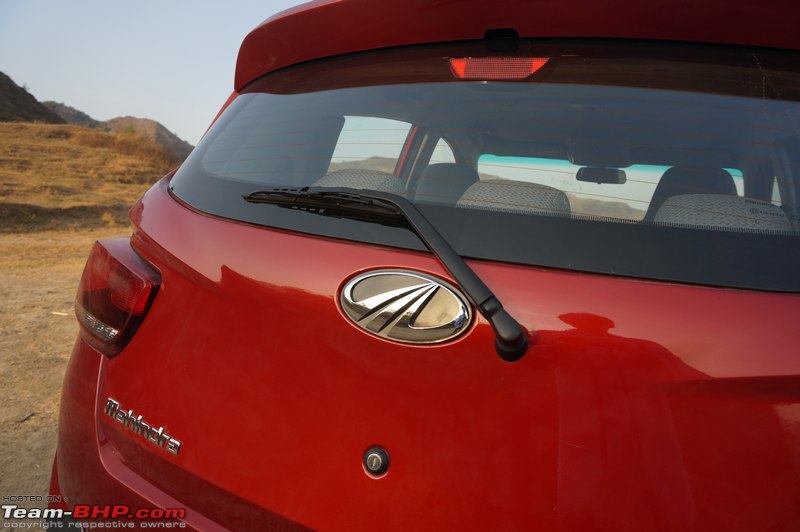 Over & above the brand logo seen above, a 'Mahindra' badge is displayed on the left side... 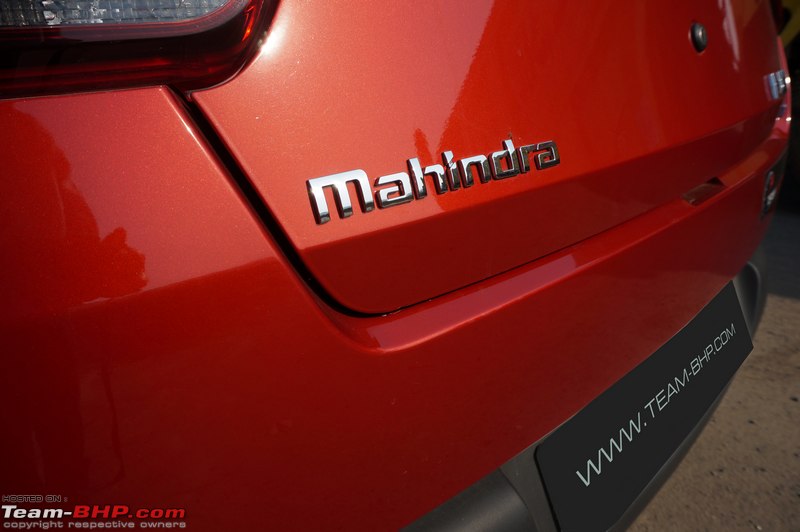 …while the model and trim level are indicated on the right: 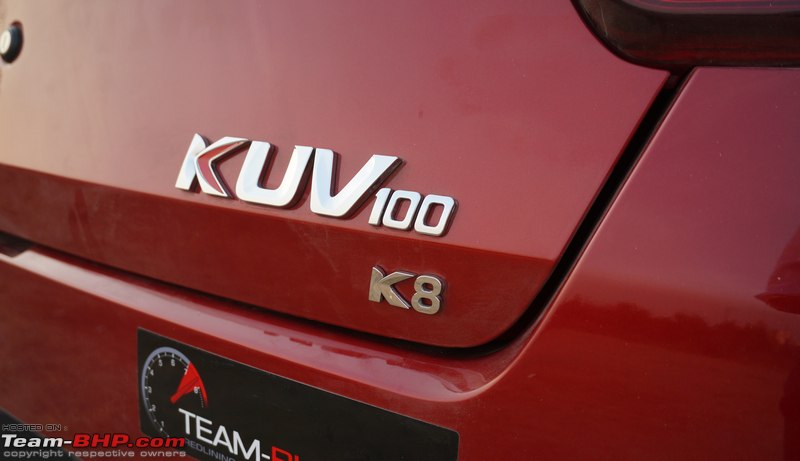 Turn the key anti-clockwise to open the hatch. The alarm will go off if the boot is unlocked this way (when the car is locked). The alarm won't go off if the boot is unlocked with the lever below the driver's seat (even if the car is locked): 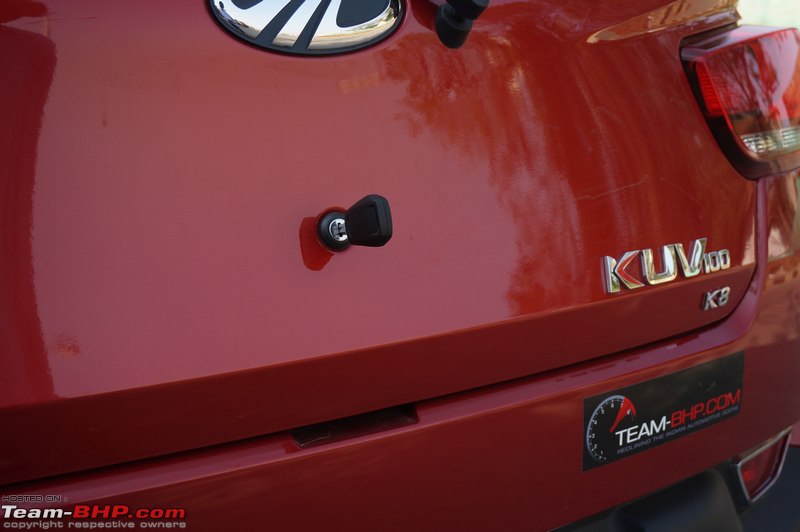 Like at the front, the bottom part of the rear bumper too is in black. However, there is no skid plate here. Exhaust pipe peeps out from the right side: 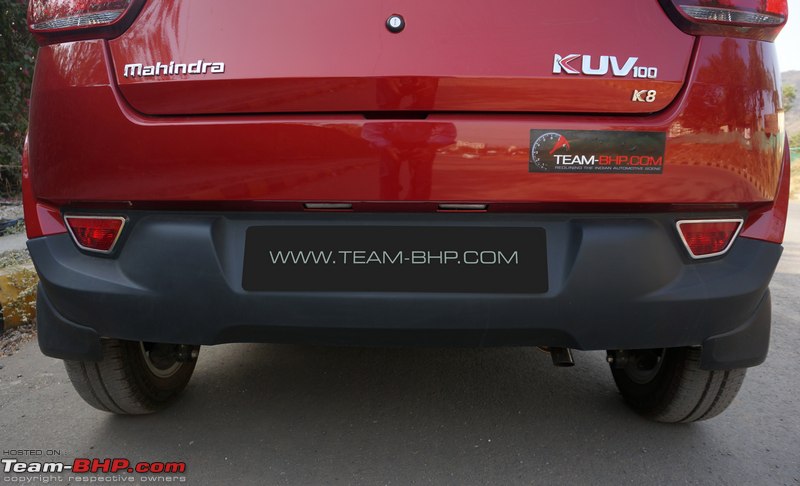 The bumper has a foglamp on each side. Like the front foglamps, the ones at the rear come with chrome surrounds: 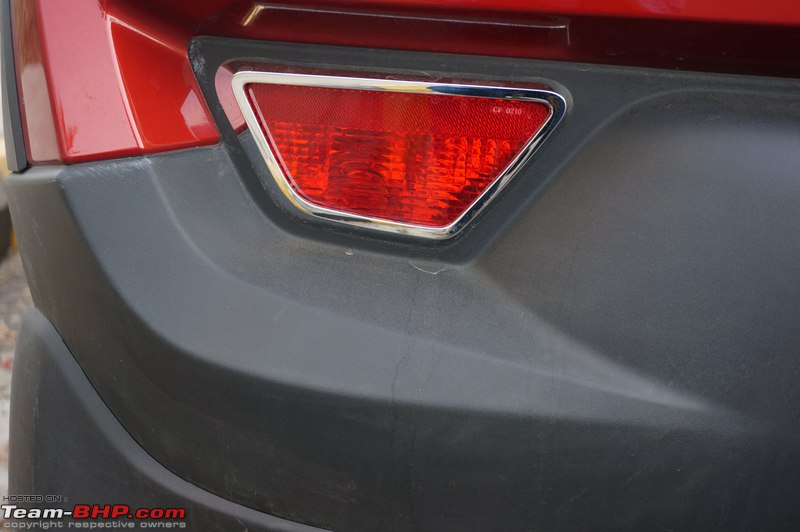 Shut lines are inconsistent around the bonnet and tail gate areas: 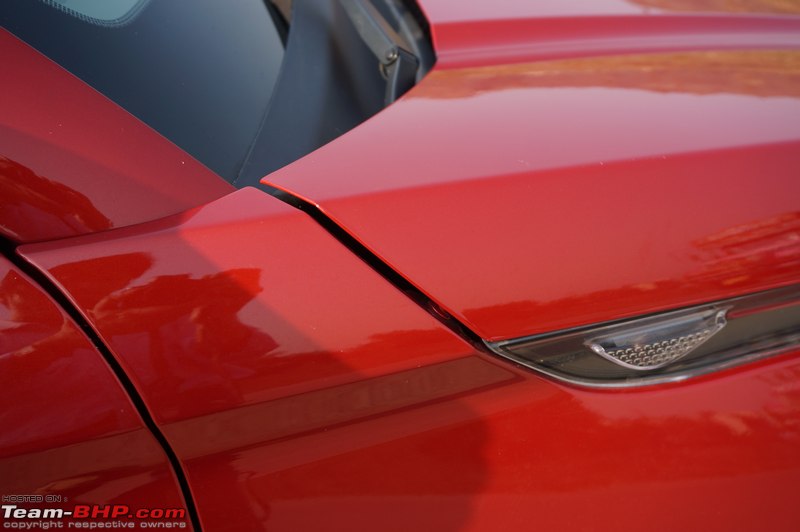 Healthy amount of protection at the front: 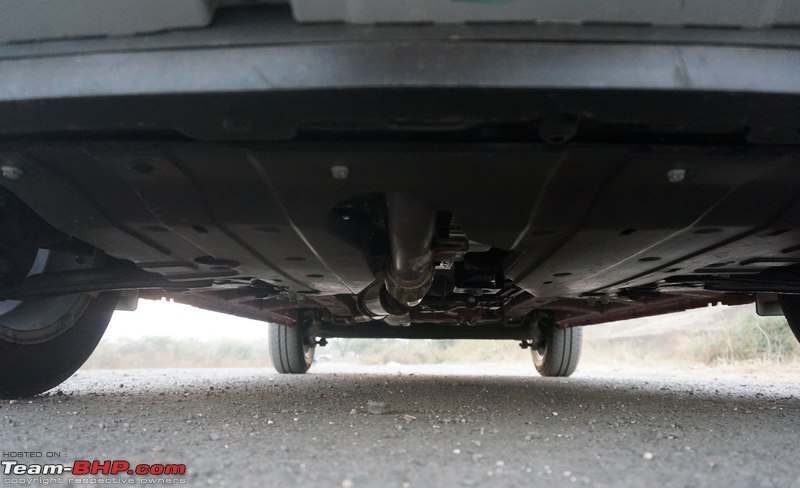 Semi-independent twist beam suspension at the rear: 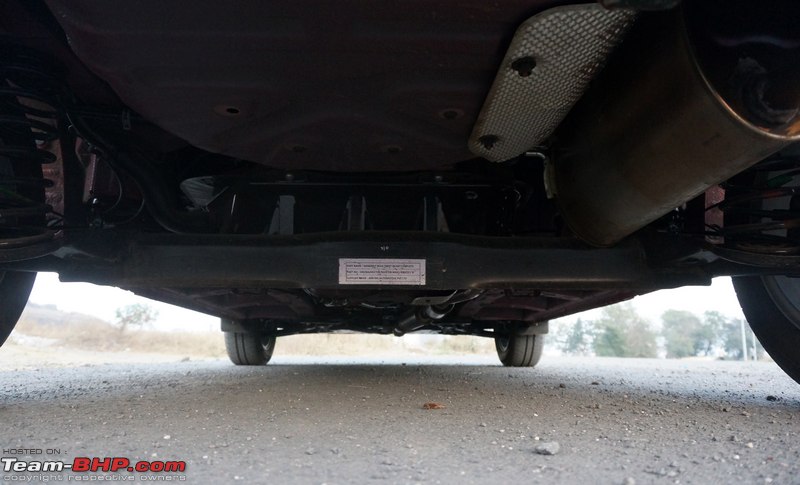 Much quirkier than a conventional hatchback. After viewing the side, one of GTO's friends commented "Thank God Mahindra bought Pininfarina":  Last edited by GTO : 6th March 2016 at 21:56. |
| |  (36)
Thanks (36)
Thanks
|
| The following 36 BHPians Thank Aditya for this useful post: | Aficionados, AutoIndian, BNM, dkaile, drive2eternity, girishglg, GTO, hemanth.anand, hmansari, InControl, joe_antony, jomson13, jpcoolguy, manij, mrbaddy, MSAneesh, Nilay, noopster, parsh, peterjim13, phynix123, Rajeevraj, RavenAvi, rshanker, RSR, samabhi, scopriobharath, SDP, swiftnfurious, Tanveer_2558, Technocrat, theexperthand, timuseravan, Tushar, Venku2015, vishy76 |
| | #3 |
| Team-BHP Support  |  No smartkey here. Press the unlock button on the remote and all doors unlock with a loud click. The front doors of the Mahindra KUV100 open wide in a three-stage action. This, along with the height of the car, makes getting in easy. The running board is not wide either, so one doesn't have to stretch his legs far while getting in or out. Ingress & egress are as easy as in tallboy hatchbacks. The dashboard sports a dual-tone colour scheme. It has a piano black insert running across its length, with silver inserts on the center fascia, instrument cluster and steering wheel. The piano black section looks good. The top of the dashboard has a lighter shade of greige (greyish beige) with a unique texture. This colour scheme & texture are carried over to the doorpads as well. The large amount of beige lends a feeling of roominess to the interior & the overall colour scheme itself will be universally liked by everyone. Like on the outside, the cabin's design is unique in some ways. However, unlike the exterior, Mahindra hasn't gone overboard. What'll definitely catch your eye is the dash-mounted gear lever and bench seat (more on them later). The quality of most plastics is acceptable. Parts that occupants are likely to touch are decently finished. 'Acceptable' is the key word here - it's nowhere close to the Grand i10's fit & finish, but neither is it a deal breaker. The cabin quality will do just fine & we don't foresee owners complaining. Scrutinize and you'll see rough finishing on the handbrake, door pockets and sun visors, but again, that's only if you look closely. For all practical purposes, it's alright for a budget hatchback. Considering this is Mahindra's first shot at a mass market hatchback, what they've done is remarkable, even though there are a couple of flaws. Space at the front is good. At 5'10", I had a fair amount of headroom and legroom. If there are only two occupants at the front, there is more than enough shoulder and elbow room for them. As a differentiator, Mahindra has provided a third seat in the middle and if it's occupied, things do get cramped. There is very little knee room for the occupant of the middle seat and he'll want to place his legs on either side of the center console, which means that the others will be disturbed. Let me make it clear that the center seat isn't for an adult. A child can fit in here, but kids are simply not safe on the front seat of any car. The fabric seats are well-stitched and the quality of material feels very durable. The driver's seat is firm and offers adequate lateral, under-thigh & back support. No complaints. It's also height-adjustable with a healthy range, and finding a comfortable seating position is easy. The big headrests / neck restraints aren't adjustable though - they are the fixed type. Because of their size, they might suit most occupants. However, in what is an extremely stupid move, Mahindra has gone & placed rock hard silver inserts in them. If you are rear-ended, the silver area could cause serious injury. What was Mahindra thinking? The steering wheel is all-plastic and gets thumb contours. It is soft & nice to hold. However, the horn pad is inconvenient to operate. It's not easy to reach and the pad itself requires a hard press. The steering gets integrated buttons for audio and telephony. As is the norm in this segment, the wheel has adjustment for rake only (not reach). The positioning of the gear lever is unique - it sticks out of the center fascia. Frankly, I found this position extremely convenient to use. The distance between the gear lever and steering is limited, thus your left hand doesn't have to travel much between the two. Further, the middle seat can be folded down and serves as a wide & comfortable armrest for the driver. The armrest comes right in line with the gear lever, making it very convenient for the driver. In fact, it's so wide that even the front passenger can comfortably use it. No car in this segment offers a useable armrest for the passenger, so that's a USP. After experiencing Mahindra's UVs and their clunky gearshifts, I wasn't too optimistic of the KUV100's shift quality. Boy, was I left surprised. I loved the gearshift - it's smooth & light to use. The instrument cluster is simple and easy to read. It has a tachometer on the left and a speedometer on the right with white markings + red needles. An MID sits in between, with a digital temperature gauge, digital fuel gauge, gear position indicator, odometer and two trip meters. The gear position indicator is useless - why would I want to know what gear I'm currently in? Newbie drivers would prefer something more intelligent like an upshift / downshift recommendation tool. From the driver's seat, frontal visibility is satisfactory only for taller occupants. Average sized folk will find the dash to be placed too high. There's another problem with the dash - that light dashboard cover leads to an annoying reflection (on the windshield) when driving under direct sunlight. The A-Pillars are thick, but they don't hamper visibility too much. The side & rear views are poor. The car has its rear door handles mounted in line with the windows. This blanks out visibility in that area. The small rear windshield, small rear windows and the large neck restraints makes all-round visibility poor. The driver has to be careful at intersections, while reversing / parking and even when changing lanes. While most of the controls are logically laid out, the KUV100's interior does have its share of flaws. The light and wiper stalks are placed a little too far back for those with short fingers. This is noticeable when one needs to flash the headlights - something you should be doing without taking your hand off the steering wheel. The outdated Qualis-style handbrake is located on the center console and has to be pulled to engage. To pull it, the driver must place his hand below the unit as there is very little clearance from the plastic above. When pulled, the driver's left knee is likely to hit the handbrake. Even a light hit is enough to disengage it! Further, the middle seat is an extension of the passenger's seat and moves front and back with it. With this seat in full forward position, it is impossible to pull the handbrake. If the seat is occupied, pulling the handbrake will be very difficult as well. While the KUV100 comes with a dead pedal, its positioning is awkward. The dead pedal is placed too far to the left and the driver certainly won't find it convenient to use. Lastly, the way that the center fascia is positioned, it can interfere with the left leg of some tall drivers while operating the clutch. Be sure to test-drive at length and see if this is an issue for you. The ICE head-unit has a small information screen and the usual set of inputs (Bluetooth, USB, AUX). Unfortunately, sound quality is poor. We remember complaining that the TUV300 also had very basic speakers. Mahindra surely needs to invest some more $$$ in better hardware as few customers will ever go & upgrade the speakers (BHPians definitely will if they buy the KUV100). The controls for the air-conditioning include 3 large vertically stacked knobs with chrome inserts. They are big and easy to use. The buttons for the a/c compressor, rear windshield demister and recirculation mode are to the right of the knobs. The center air vents are small, although the ones on the side are adequately sized. The cooling power of the KUV100's air-conditioner is superb! Even on a hot day, the interiors were cooled in no time. The blower however, is rather noisy...quite audible even on position 2. On levels 3 and 4, it gets uncomfortably loud. In terms of storage, the KUV100 has a medium-sized glovebox with a cooling vent, pen holder and card holder. There is a small glovebox on the driver's side as well (to his right). The front doorpads can hold a 1-liter bottle as well as some knick knacks, while the front armrest houses a pair of cup-holders. There is a sunglass holder above the IRVM and the driver's side sunvisor gets a ticket holding strap. Neither of the two sunvisors have vanity mirrors though. The party piece is a storage bin placed below the passenger's seat. This bin can be accessed by tumbling the seatbase forward. It even has a pair of handles that you can use to carry the bin around. The bin is fairly long & deep. It can take loads of up to 10 kg, but the dimensions won't allow a laptop to fit in. We placed our camera bag in it (was safe too) and your wife could squeeze in a handbag or two. If driving long distance, you could park snacks in here. One person commented that it's the best way to transport a ton of jewellery & cash  . The fact that it's out of sight makes it a more secure spot than the glovebox or boot. . The fact that it's out of sight makes it a more secure spot than the glovebox or boot.The KUV100 gets a beige dashboard with piano black inserts & a unique textured finish on top. Interior quality is acceptable, but don't compare it to a Grand i10:  The dashboard cover. Looks nice, but causes an annoying reflection on the windshield:  Steering is soft and has thumb contours. No leather, still nice to hold. Silver insert helps give it an upmarket look. Hornpad is a stretch for your thumbs & is hard to press too:  As is the segment norm, the steering is tilt-adjustable only (not for reach):  Steering-mounted buttons on the left for audio & telephony. Big size makes them easy to use. Call accept / reject buttons double up as track / radio frequency seek controls. Good to see a mute button here:  Instrument cluster is simple, clear and easy to read. Cost-cutting means the same revv counter for petrol & diesel:  MID has temperature and fuel gauges, gear position indicator (useless), odometer and two trip meters. While neutral and reverse are displayed with the clutch pressed, the forward gears aren't until the clutch pedal is released. Low fuel warning lamp comes on when the fuel gauge is down to the last level. The odometer stays on for ~5 seconds after the car is switched off:  Simple wiper & light stalks. Those with short fingers will find them to be placed too far away:  Illuminated key ring:  Controls for the headlight leveller, ORVMs, disabling the engine start-stop feature and power / eco driving modes (diesel only) are to the driver's right. Mahindra has smartly badged the start-stop button as "ESS", as if to make it sound as cool as "ESC". All switches on the dashboard are illuminated in an icy blue at night:  Engage ECO mode however and it'll light up in green:  Power mode is in orange. On starting the engine start-stop system, an orange light located on the button comes on. Good thing that ESS remembers your selection even after you restart the car (trust me, you'll keep it switched off):  Nifty storage compartment on the driver's right:  Doorpads with the same colour theme as the dashboard:  Top of the doorpad gets the same design pattern as the top of the dashboard:  Door handles get blue ambient lighting, which fades out gradually (theatre-dimming effect):  Simple switchgear for the power windows. They are illuminated in the same icy blue. None of the windows get one-touch up / down:  Area where you'd rest your arm gets a fabric insert. It is placed at a comfortable height for the driver:  Door pocket can hold a 1-liter bottle and the knick knacks:  No scuff plates on the door sill:  Driver's chair provides satisfactory support. This is the '6 seater' version (pics of 5 seater version later in the review). The middle seat is attached to the passenger seat and comes with a lap belt. It's not suitable for an adult (won't fit) or even a child (not safe):  Driver's seat is adjustable for height. Adjustment lever is robust:  Here's a closer look at the seat upholstery. Fabric feels durable:  Big fixed neck restraints at the front (not for middle passenger though). Silver cutout looks nice, but we're worried about the injury potential to a short driver if he's rear-ended. You don't want your head hitting back on a rock hard surface! Mahindra should know that the entire neck restraint should be made of soft material:  Middle seat can be folded down via this lever. It's a stretch for the driver to reach, so don't fold on the move:  Folded down, the middle seatback turns into a wide & comfortable armrest for the driver & front passenger. It has two cup-holders as well:  A closer look:  With the seatback folded down, buckling the seatbelt can be a bit tricky, especially for those on the heavier side:  Pull this strap to tumble the passenger + middle seatbase:  Tumbling the passenger seat forward gives access to the underseat storage. The metal bits around the bin don't have any sharp edges - pleasantly surprising in a Mahindra:  Under-seat storage is in the form of a removable plastic bin. It has handles, high sides and is very accommodating. Can carry upto 10 kg!  Middle seat is attached to the passenger seat and moves forward / backward with it:  Front seats touch the center console in full forward position. Handbrake and 12V power outlet cannot be used when the seat is in this position. Not that anyone will pull the seat all the way forward, unless it's due to cargo requirements at the back:  Middle seat isn't suitable for adults. Not enough width...  ...and no legroom. Even with the seat all the way behind, this is the situation. In an accident, your knees will be crushed by the center console:  Black flooring is practical. A, B & C pedals are properly spaced out. A dead pedal is provided, but…  …it's positioned poorly. Too much on the left. Not convenient to use:  Bonnet release lever is located on the right:  Boot and fuel flap release are conventionally located, but not perfectly aligned. In this image & the ones above, it's evident that the rubber mat doesn't 'sit' properly:  ORVMs are tall enough, but too narrow:  IRVM has manual day/night adjustment. In our test car, this mirror wasn't firmly attached - it was shaky: 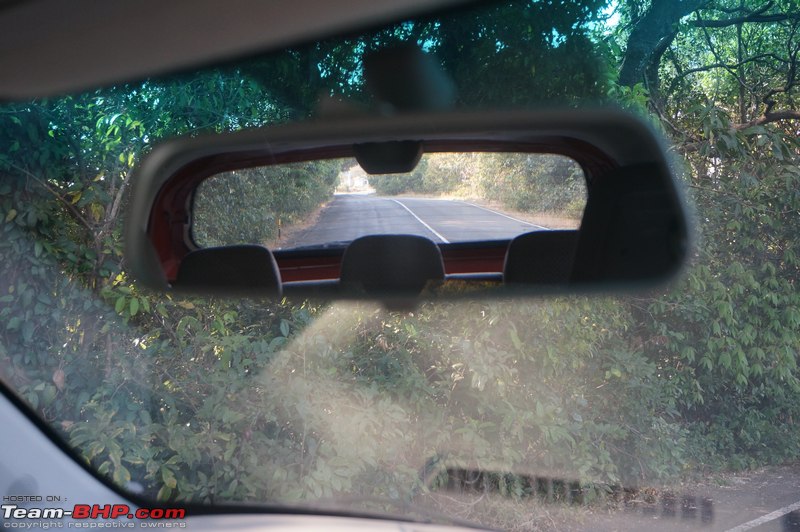 Thick C-Pillars, small rear windscreen and sloping roofline mean poor visibility. If the headrests are pulled up, rearward visibility gets worse. This is a car that needs parking sensors; it's a big oversight on Mahindra's part to not provide them even on the K8 variant. A reversing camera is available as an official accessory: 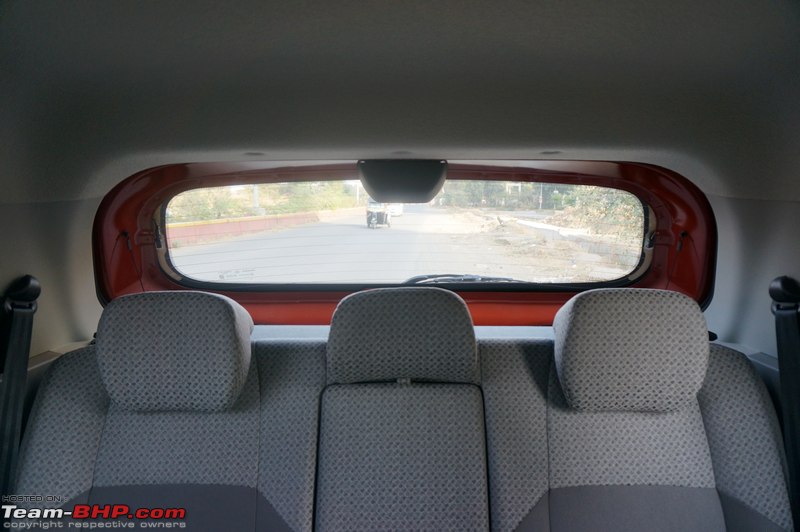 Center console gets KUV100 branding and a thick silver border. Looks different, in a nice way. Gear lever is ergonomically perfect. It's also very smooth to use:  Controls for the air-conditioner are stacked up vertically. Looks sweet! These chrome-ringed knobs are big and easy to use. Air-con is very effective. Climate control not available even on the top variant:  Center vents are on the smaller side. They get air volume control too. When shut, some amount of air still passes through:  Side air-con vents are uniquely styled. These get air volume control as well: 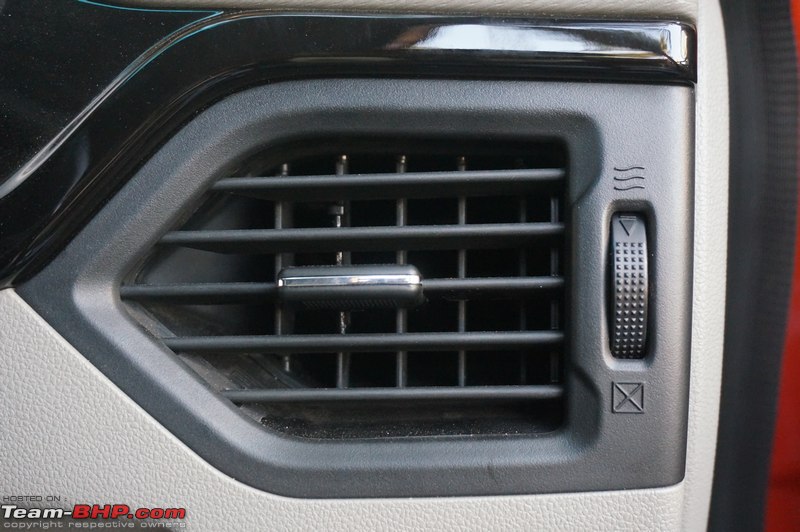 Basic head-unit with a small display (covered in detail later). AUX & USB slots are placed here, resulting in dangling wires. The system also comes with Bluetooth connectivity and supports the Blue Sense smartphone app. Sound quality is poor: 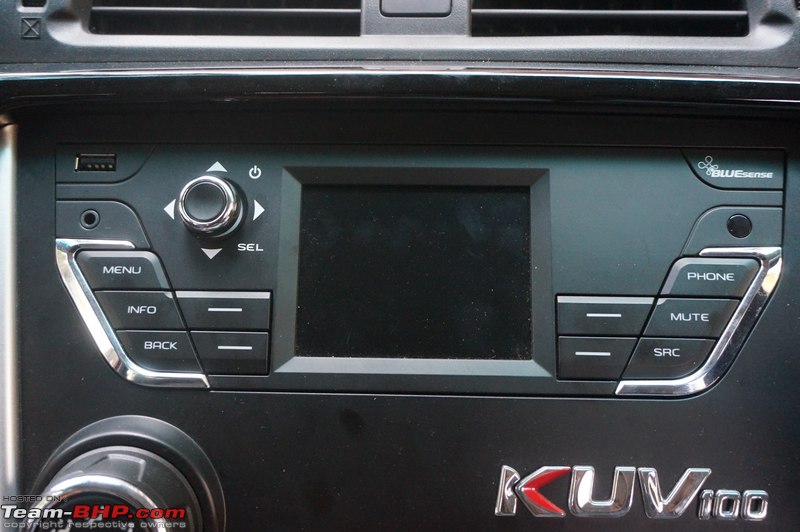 To engage the parking brake, pull the lever out. Twist it clockwise to release. Awfully outdated arrangement that was seen in the Datsun Go & Toyota Qualis: 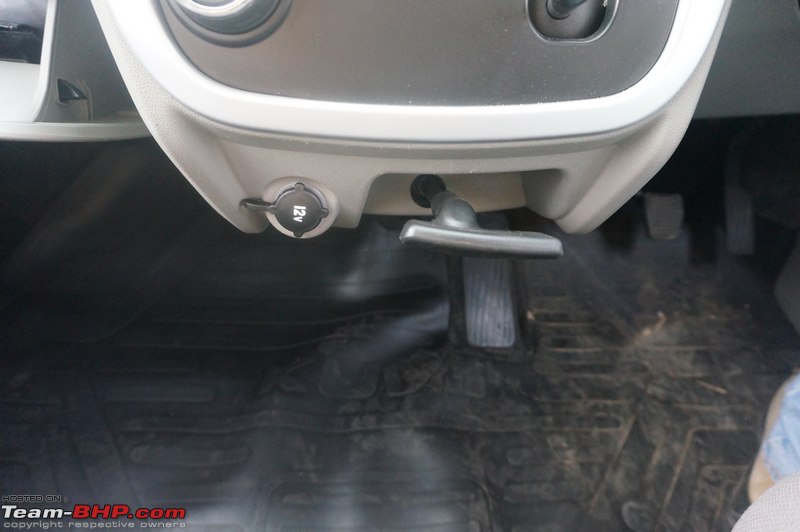 12V power outlet is located next to the handbrake, but where will you place your smartphone? In the center armrest cup-holder (5-seater variant gets a storage console between the seats): 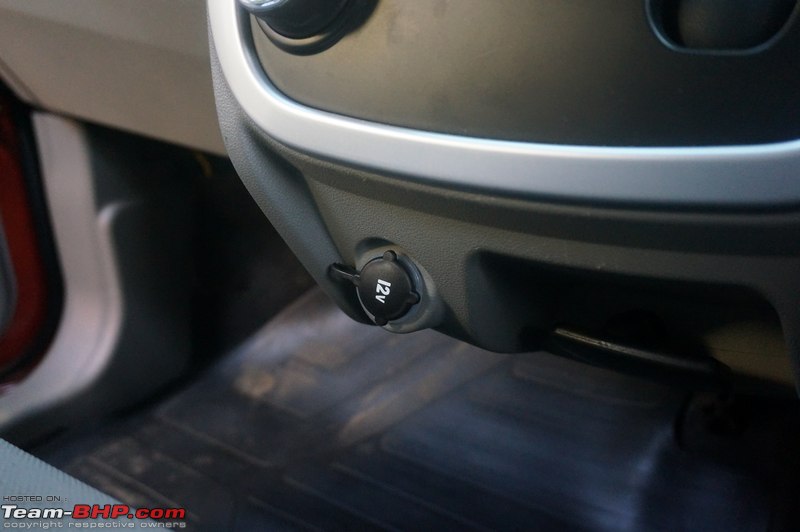 Glovebox is medium-sized and has a cooling vent:  Glovebox comes with a pen and card holder: 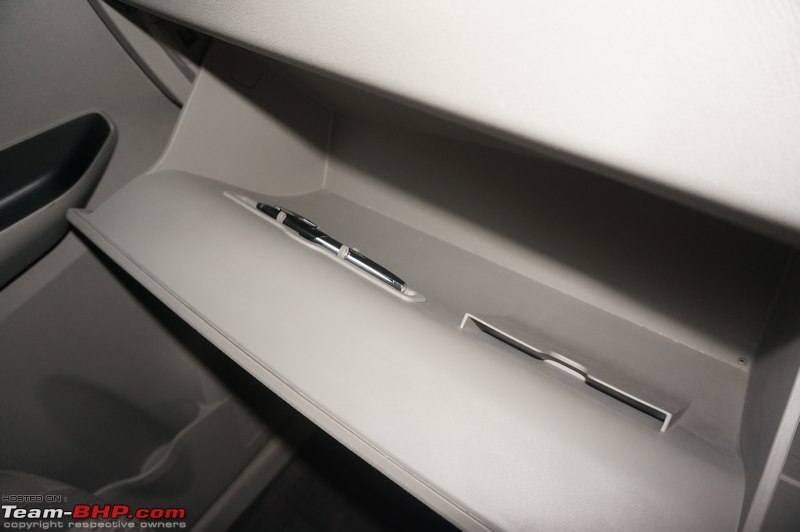 Cooling vent inside gets a shutter that you can slide down: 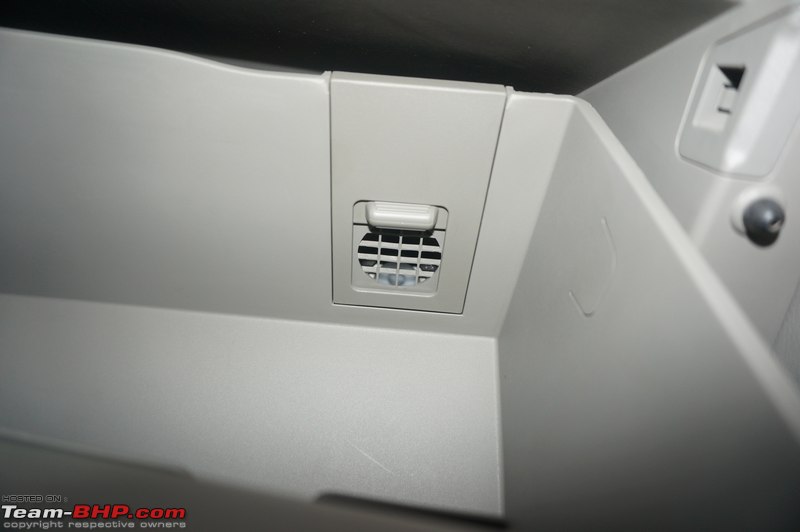 Roof console holds the Bluetooth mic, button for ambient lighting and sunglass holder. The switch on the left is a dummy: 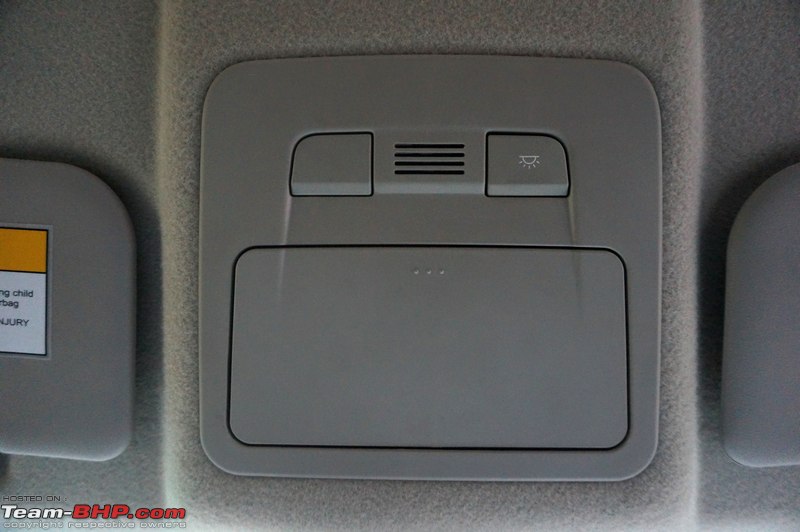 Sunglass holder has a protective lining: 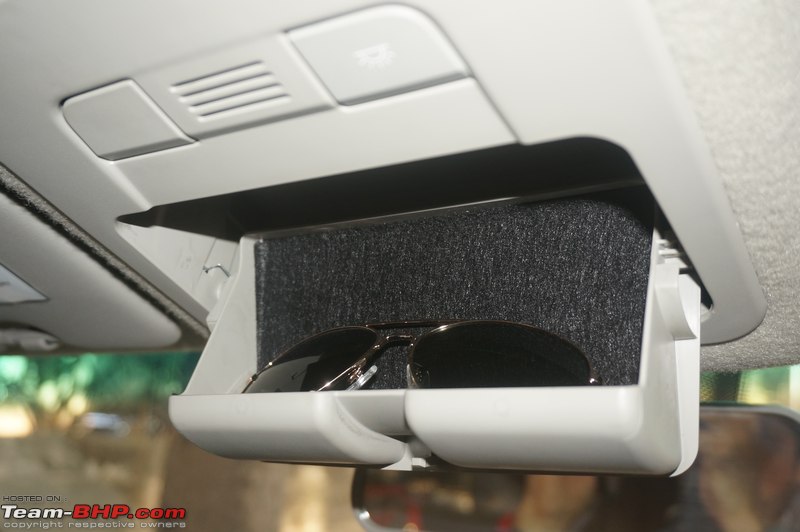 Driver's sunvisor gets a strap to hold tickets. No vanity mirror. Passenger sunvisor gets nothing: 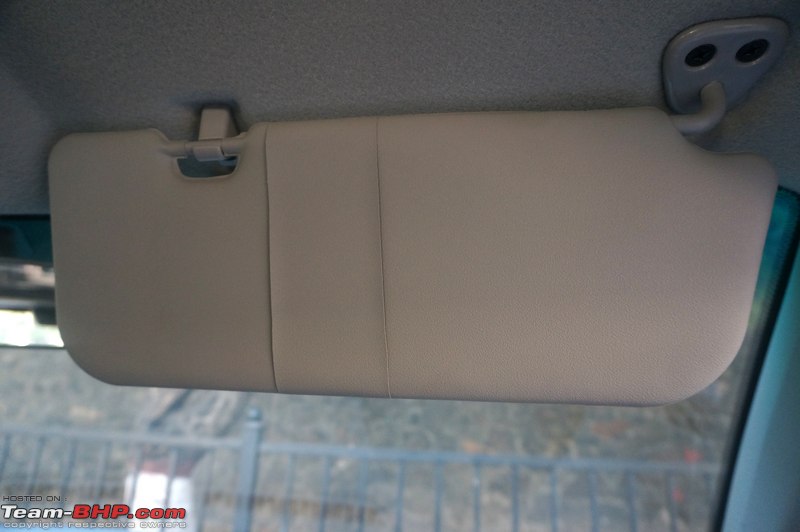 Seatbelts aren't adjustable for height, but their positioning will be comfortable for most occupants: 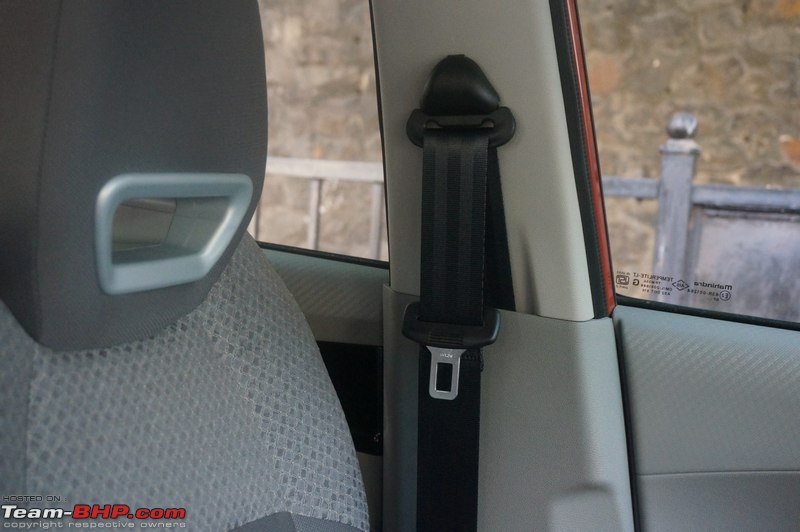 Dual front airbags are available as an option on all variants (standard on the top). Superb move. We hope all manufacturers take this step in the right direction: 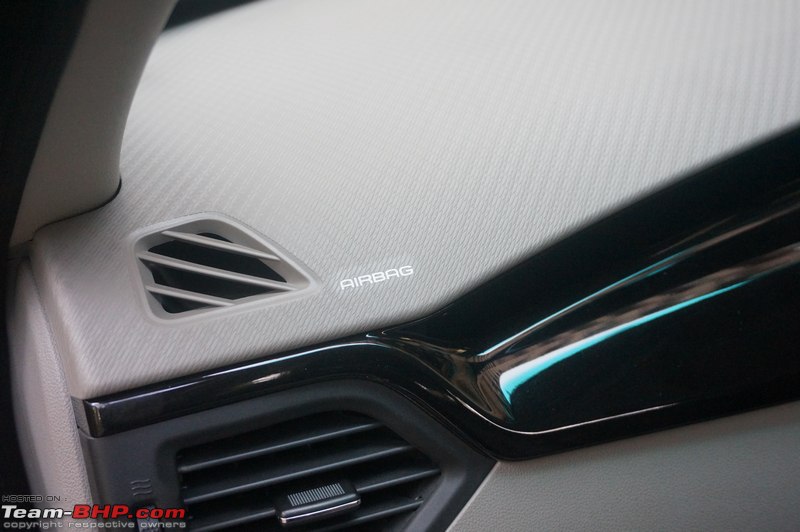 Beam runs across the roof between the B-Pillars. Cabin light is located on it: 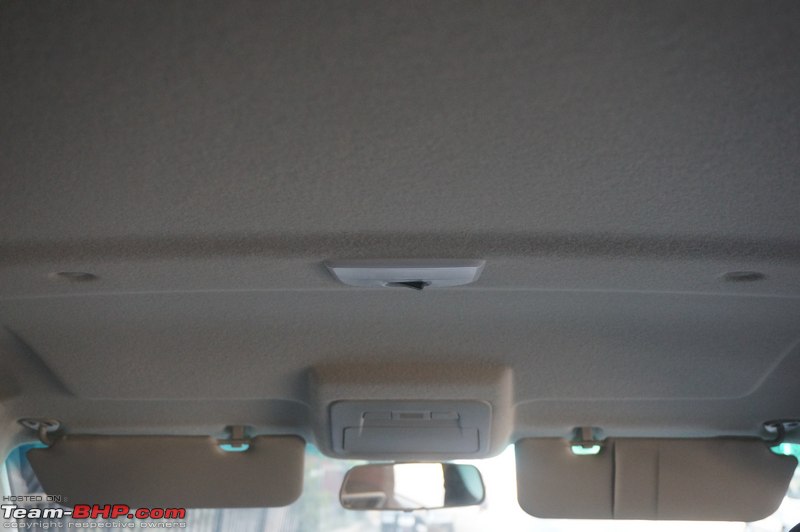 Center-mounted LED cabin lamp emits a brilliant white light and has a theatre-dimming effect: 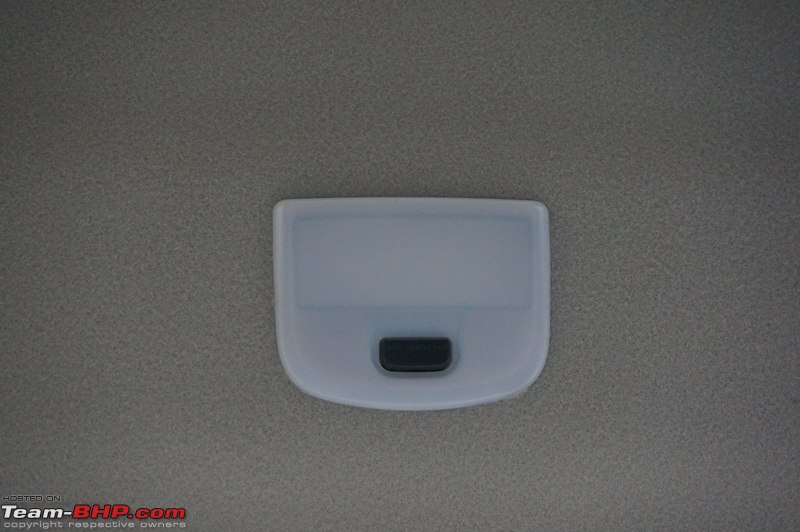 Last edited by GTO : 6th March 2016 at 21:36. |
| |  (20)
Thanks (20)
Thanks
|
| The following 20 BHPians Thank Aditya for this useful post: | Aragorn, dkaile, drive2eternity, GTO, hmansari, MaheshY1, MDED, mrbaddy, MSAneesh, msdivy, parsh, phynix123, RavenAvi, RSR, samabhi, samaspire, scopriobharath, Technocrat, theexperthand, vibbs |
| | #4 |
| Team-BHP Support  | The rear doors open in a two stage action. Getting into the car isn't as easy as the other tallboys due to the shape of the door & sloping roof. Sitting at the back with the driver’s seat in my own position, at 5’10”, I was able to fit in. Legroom is much better than the Swift, although it's lesser than the Baleno (somewhere in between). The front seatbacks are scooped out, further aiding knee room. There is also enough space below the front seats to slide your feet under. On the flip side, under-thigh support for tall people is inadequate. With my height, I had to sit with my knees up a little (refer to pics below). Three adults could fit in here. The seat base is flat and there are no contours to speak of - it's a basic bench. The armrest doesn't protrude when it's tucked in and the floor is flat as well. The seat compound has the right amount of firmness while the backrest angle is comfortable. The backrest isn't as upright as is the case with many competitors. Additionally, Mahindra has provided three adjustable neck restraints for occupants to use. These headrests are firm, but not rock hard. The door armrests and the center armrest are placed at a comfortable height, making them very usable. Like at the front, the rear doorpads get fabric inserts where you'd rest your forearm. What isn't cool is the headroom. Sitting straight, I had just about an inch of space between my head and the roof. 6 footers will find it a challenge to sit here for long; God help you if the driver misses slowing down for a bump. Another problem is the blacked out panel on the rear windows (due to the placement of the external door handles). This black panel falls exactly at the spot where rear passengers would look out of the window. It severely restricts the outside view. There's a solid reason why so many cars have a quarter glass here. The rear doorpads carry over the same theme as the ones in the front and have a 1-liter bottle holder with additional space for storing small items. The center armrest has integrated cup-holders, while the two seatback pockets are deep. Additionally, there is an underfloor storage cubicle. To access this cubicle, you have to remove the floor mat and lift the lid. The area can be used to store small to medium sized items. Important to mention, the RHS seat (behind the driver) is equipped with ISOFIX mounts to attach a child seat  . .The KUV100 has a 243-liter boot which is larger than that of the Swift, but a little smaller than the Grand i10 (256 liters). It has a high loading lip and the mouth is too narrow, thanks to the fixed, one-piece tail lamps. Loading bags in here will require more effort. Additionally, there are intrusions on both sides by the rear suspension. Luggage space can be increased to 473 liters by folding the rear bench down (no 60:40 split though). The seatbase can be tumbled, allowing the seatback to be folded some more (still not completely flat). There is adequate cladding in the boot to hide the metal parts and wiring. A parcel shelf and boot lamp have been provided, along with a 12V power outlet behind the rear seat. The spare is a full-sized tyre on a steel wheel. While accessing it, one has to ensure that the rear seatback is erect. If it is folded forward, removing the spare wheel can be difficult as a portion of the seat protrudes into the wheel well. Sloping roof & door shape mean ingress to the rear isn't as easy as in other tallboys:  Doorpads have an identical theme to the ones in the front. Piano black & fabric inserts too:  Door pockets can hold a 1-liter bottle, with space left over for a small item:  A flat rear bench. Not richly contoured:  3 adjustable neck restraints. Center armrest doesn't protrude after it's folded in:  Rear legroom is adequate:  Scooped out seatback and a deep storage pocket:  At 5'10", there is enough legroom for me with a reasonably sized adult in the front. As you can see in this image, headroom is poor:  The space behind my own driving position. In a car that's shorter than the Swift, Mahindra offers more cabin & boot space! The company has excellent packaging skills:  Even if you push the front seat all the way behind, I can still fit in:  View out of the rear window. Black panel severely restricts visibility as that's exactly where the rear passenger's head is:  Yes, rear windows go down all the way:  Rear seat has an armrest with two cup-holders. It's wide & very useable:  ISOFIX mounts for a child seat:  F-l-a-t floor at the rear. No hump:  Very uniquely, there's an under-floor storage area here:  Door handles touch the front seat if it's in full back position. This much is enough to open the door though:  Rear seatbelts are mounted on the C-Pillar:  12V power outlet is located behind the rear seat:  Fixed grab handles. No coat / bag hooks provided:  243 liters of boot space. The mouth is too narrow, due to the single piece tail-lamps:  Usable space is much lesser than what its on-paper spec would have you believe:  Boot is suitable for carrying small to medium sized bags only:  Handy parcel tray comes with a prominent border:  If you want a flatter cargo area, pull this strap to tumble the rear seatbase:   With the seatbase removed, the seatback can rest lower down:  Folding the rear seat gives you cargo capacity of 473 liters:  High loading lip and fixed one-piece tail lights means a small mouth:  Tail-gate gets a cladding on the inside:  Strap to pull down the hatch when it's open:  Hatch is helped up by pneumatic struts on both sides:  KUV100 branded rubber mat for the boot floor:  Boot lamp is located on the left side:  Top tether for the child seat:  Lift the boot carpet up with this strap to gain access to the tool kit & spare wheel:  Tool kit is neatly arranged in the spare wheel:  Another look. Screwdriver & spanner provided and they're held properly in place:  Nope, the spare isn't an alloy wheel:  While most of the wiring is well-concealed, bits like these stick out like a sore thumb. Mahindra should have used a plastic cap on the demister. Looks so ugly & unfinished:  Last edited by GTO : 6th March 2016 at 22:10. |
| |  (21)
Thanks (21)
Thanks
|
| The following 21 BHPians Thank Aditya for this useful post: | Aragorn, dkaile, drive2eternity, gearedup, GTO, hmansari, MaheshY1, mrbaddy, MSAneesh, parsh, phynix123, Ponbaarathi, Rajeevraj, RavenAvi, RSR, samabhi, samaspire, Technocrat, theexperthand, vibbs, vikred |
| | #5 |
| Team-BHP Support  | In-Car Entertainment The KUV100 comes with an integrated infotainment system. It accepts the usual lot of modern inputs (USB, AUX and Bluetooth streaming). The ICE also supports the Mahindra BlueSense app. The small 3.5" screen is similar to the unit seen in the TUV300. However, it has a simple black, white & grey display and doesn't look as nice as the TUV300's unit. This is a very basic screen. There is also a noticeable delay between the pressing of a button and the actually function being performed, which can get irritating. Bluetooth pairing requires one to go through multiple screens and this, coupled with the lag, can get on your nerves. I strongly recommend not attempting this on the move. Sound quality from the 4 speakers + 2 tweeters is poor. We wish Mahindra had a superior ICE solution, and one with an integrated display for parking sensors (or better yet, a reversing camera). This is especially important due to the awful rearward visibility. To start the system, you have to press the joystick for a short duration. To switch it off, long press. While the buttons are simple & sturdy enough, the joystick is flimsy and doesn't feel like it will last the distance. Its operation can get tricky - I had trouble starting and switching off the system at times:  A look at the tweeter mounted on the A-Pillar:  Door-mounted speakers:  Usual sound settings, including a graphical fader:  Speed dependent volume control can be set to three levels, or turned off altogether:  Pressing the mute button (on the head-unit or steering wheel) actually pauses the track being played. I like this arrangement (instead of missing the song):  Telephone numbers appear under separate alphabetically-arranged groups. Nice!  Another cool feature. You can switch between private & hands-free modes while talking on the phone:  Among other things, you can jump straight to your missed calls:  The infotainment system displays vehicle related information such as distance to empty and alerts (low fuel, seatbelt open, low brake fluid, handbrake engaged, exactly which door / bonnet is open, high engine temperature and low engine oil pressure). Shockingly, average & real-time fuel efficiency data aren't provided!  After switching off the engine, the infotainment system can be used for one hour, post which it will go off on its own:  The KUV100 gets Mahindra's BlueSense smartphone app:  Some of the settings that you can enforce:    You can even view some vehicle data:  Check the status of the park lamps:  The audio system can be controlled from the App. Change radio channels, the source, play / stop / switch tracks and adjust the volume:  You can choose which warnings you want to receive:  E.g. a warning if any door is open:  You can set up reminders for various tasks:  E.g. renewing the insurance:  You can add your pic and personal details. From the business POV, Mahindra could make good use of such data for targeted marketing campaigns, announcing events (e.g. multi-day great escapes), contacting you for feedback on the car & dealer etc.:  Last edited by GTO : 6th March 2016 at 21:34. |
| |  (16)
Thanks (16)
Thanks
|
| The following 16 BHPians Thank Aditya for this useful post: | Aragorn, drive2eternity, GTO, MaheshY1, mrbaddy, needforspeed88, paragsachania, parsh, Ponbaarathi, RavenAvi, RSR, scopriobharath, Technocrat, theexperthand, vibbs, Vik0728 |
| | #6 |
| Team-BHP Support  | The KUV100 is available with two 1.2L engines, a petrol and a diesel. Both are 1198cc, BS-IV compliant, 3-cylinder motors from Mahindra's new mFalcon engine family, which has been developed in collaboration with SsangYong. The petrol is an aluminium engine with variable valve timing on the intake & exhaust sides. It develops 82 BHP (@ 5,500 rpm) and 115 Nm of torque (@ 3,500 - 3,600 rpm). The diesel deploys a fixed geometry turbocharger with an intercooler. It produces 77 BHP (@ 3,750 rpm) and 190 Nm of torque (@ 1,750 - 2,250 rpm). These power figures are in line with the segment averages. However, the KUV100's kerb weight is about 10% more than the likes of the Swift, so don't expect the same performance. All Mahindras score on driveability and these two engines are no different. They are very city-friendly. Driving the G80 1.2L Petrol: Mahindra has named the 1.2L petrol engine as the "G80". On cranking, it does make some noise, but then settles into a quiet idle at around 800 rpm. However, vibrations can be felt inside the cabin - more than what you'd expect in a petrol! This leaves a poor first impression. Moving off the line is easy for the G80. It has no trouble keeping up with city traffic. One can shift up early and the car pulls ahead easily. Driveability is good and frequent downshifting won't be required in traffic. The gearbox has ratios on the shorter side - that definitely helps here. The vehicle can move around town at 40 kph in 4th and 50 kph in 5th gear. That said, the KUV100 isn't a sprightly performer. It prefers to go about its business in a relaxed manner. While things were comfortable in the city, it's a different story on the highway. The KUV100 petrol isn't a fast performer. It's best to move out of the fast lane & drive calmly. This engine is purely a point A to point B commuter. Overtaking will require a downshift and you need to revv the engine to extract performance out of it. When pushed, the engine will revv to 6,000 rpm. There is a positive here - the engine sounds amazing at high revvs (throaty sound, as if it has a K&N Typhoon intake). Downside? Revv hard and you'll see the air-con compressor cutting off easily. Good thing that the air-con is powerful enough to bring you back to comfort soon. Open road performance is acceptable up to 100 - 110 kph, but it tapers off after. In terms of cruisability, at 100 kph in 5th gear, the engine is turning over at ~3,200 rpm. That is almost 500 rpm higher than its competitors, due to the KUV100's short gearing. This is not a calm cruiser. The KUV100 is equipped with an engine start-stop system, which Mahindra misleadingly calls 'micro hybrid technology'. The system switches off the engine when it's idling (about 4 seconds after the clutch pedal is released) to save fuel. The start-stop light on the instrument cluster blinks thrice before the engine switches off and then, remains constantly on till the engine restarts. The motor is cranked again on pressing the clutch. However, this can be tricky. One has to press the clutch, wait for the engine to start completely and then engage a gear. At times, we noticed that pressing the clutch and quickly engaging a gear will only result in the engine cranking partially (and the car won't start). While diehard FE lovers will keep the feature engaged, most people will switch it off. We found it terribly annoying, the operation is far from seamless and the air-con's cooling is affected as the compressor switches off too. Like other 3-cylinder petrols, the G80 isn't exactly quiet and can be heard inside the cabin even at low speeds. Beyond 3,000 rpm, the engine starts getting vocal and over 4,000 rpm, it becomes very loud. Enthusiasts will love the K&N-style sound, but regular folk definitely won't. Wind noise starts creeping in at 90 kph and gets prominent at 110 kph. Tyre noise is also noticeable at these speeds; all the sounds combined can make things unpleasant at high speeds. The vehicle is at its best while being driven either in the city or ambling on the highway at 90 - 100 kph. This is Mahindra's first attempt at a small car gearbox and by God, they've got it spot on! The gearbox is smooth to operate and has short throws too. What's more, the gear lever's positioning is ergonomically perfect. It's a box you'll love to use. The clutch is also light enough to operate, but it doesn't give any feel. We wish it offered some feedback. The KUV100 petrol has an ARAI rating of 18.15 kpl. As most 3-cylinder engines are, it will offer reasonable fuel economy. While on the topic, it may be noted that the KUV100 has a 35-liter fuel tank which is small by segment standards. The G80 1.2L, 3-cylinder petrol with variable valve timing. It produces 82 BHP (@ 5,500 rpm) and 115 Nm of torque (@ 3,500-3,600 rpm):  Engine bay is narrow:  5-speed gearbox is a joy to use!  Gear lever is ergonomically perfect! Sticks out of the centre console and is easy to reach:  Engine family name & code embossed on the plastic cover:  ECU is mounted on the firewall:  Only a little insulation on the firewall:  Washer pipe plumbing looks ugly:  Nice touch - Hazard lights come on whenever the bonnet is opened. Petrol and diesel, both, get under-bonnet insulation:  Double marking (on the lid and the cover) to warn pump attendants who assume that all Mahindras are diesel:  Engine start-stop light blinks thrice before shutting the engine off. It stays on while the engine is off:  Driving the D75 1.2 Diesel: The 1.2L diesel engine has been codenamed as the D75. When idling, vibrations are well-controlled for a 3-cylinder. You can make out that it's a diesel and that typical clatter is heard inside the cabin, but things get better as you start driving. In fact, I'll go as far as to say this is among the better 3-cylinder diesels we've driven (in terms of NVH). Compare the D75 to the erstwhile 3-cylinder Polo diesel and the VW feels like a tractor! Mahindra has given the diesel two driving modes - Power and ECO. These modes basically change the active engine map. One can shift between these modes by pressing a button placed to the right of the driver. Good thing that the ECU remembers your choice of mode when you restart the car. PWR (power) is the default mode. In this mode, the KUV100 doesn't have to make any effort to move off from a standstill. Just lifting off the clutch is enough to get the car rolling. It's responsive off the block. There is very little turbo lag and power delivery is linear in nature (only a mild boost is felt). In-town driveability is excellent! The torque comes in at 1,750 rpm when the turbo starts spooling, but even below that, the KUV100 doesn't get bogged down. This makes the diesel immensely user-friendly in the city. 2nd gear on a speed-breaker? No problem. It can easily move around at low speeds in higher gears without complaining. The diesel is superbly tuned for the driving conditions that we experience every day. The diesel tops out at 41 kph (@ ~4,750 rpm) in 1st, 70 kph in 2nd and 98 kph in 3rd. On the highway, the D75 engine offers acceptable performance in PWR mode, but no, it's not a scorcher. The mid-range is decent and overtaking doesn't need frequent downshifting. That said, it doesn't have much of a top-end and does get noisy near the redline. Best to shift up earlier. While the diesel's power output matches the Swift, the latter is noticeably faster due to its lighter kerb weight & tuning. In 5th gear, the KUV100 sees 100 kph at ~2,700 rpm. Like its petrol sibling, the diesel's cruising rpm is also 400 - 500 rpm higher than the competition (again, short gearing). While neither of the engines is particularly exciting, the diesel is definitely the one I would choose. Shifting between PWR and ECO modes is possible even on the move, and the difference is immediately obvious. In ECO mode, the diesel becomes a completely different / tamer car. One needs to press the accelerator a lot more under the same driving conditions. Even over 1,750 rpm, it doesn't move with any urgency. Throttle response is much slower in ECO mode and max revvs are limited to ~3,600 rpm. If you enjoy seeing high FE numbers, ECO mode can be used in the city where the speeds are low and quick acceleration is generally not required. Even though it's pretty sluggish, the KUV100 won't have much trouble keeping up with city traffic. We can't recommend ECO mode for the highway though. The diesel is equipped with the irritating engine start-stop system as well and it works in both driving modes. With ECO mode engaged and the engine start-stop system activated, the KUV100 diesel returned an ARAI-certified fuel economy of 25.32 kpl. Unlike the petrol, the diesel's clutch does offer some feel. It's light enough to operate too. The gearbox impressed us with its short & smooth throws. Simply put, it's a joy to use. The D75 1.2L, 3-cylinder diesel produces 77 BHP (@ 3,750 rpm) and 190 Nm torque (@ 1,750 - 2,250 rpm):  Diesel is an even tighter fit:  Intercooler is placed right at the top. It's visible through the upper grille:  Both engines get underbody protection. Very little of the ground is visible from the engine bay:  The anti-theft alarm siren:  Diesel gets 2 driving modes – PWR (default) and ECO. When ECO mode is engaged, an indicator appears in the tachometer. No such indicator for PWR mode:  D75 badge on the left fender of the diesel:  Ride, Handling, Steering & Braking: The KUV100 uses a McPherson strut suspension with coil springs at the front, and a semi-independent twist beam suspension with coil springs at the rear. The vehicle is softly sprung and at city speeds, it offers a comfortable ride. The KUV100 just glides over potholes and paver blocks (although the suspension can get noisy). Keeping in mind its intended usage as a city car, the suspension is compliant. On the highway though, the ride isn't planted. While bump absorption is still good, the car doesn't ride flat. The rear end, especially, can suffer from vertical movement on undulating surfaces. Your only solution is to ease off the accelerator. Straight line stability at speeds of up to 100 kph is good as long as the road is smooth. However, the soft suspension causes the KUV100 to pitch and bounce upon hitting a bump. Things can get worse if you hit a mid-corner bump. Additionally, the vehicle is affected by crosswinds at expressway speeds. Around sharp corners, the tall stance and soft suspension result in a noticeable amount of body roll. Our recommendation is to drive the KUV100 safely & sedately. You can't push it around like a Swift. A calm driver won't have a problem with the KUV100, but an enthusiast will notice the unsorted dynamics. Like with other Mahindras, you won't have to worry about bad roads in the KUV100. The 170 mm of ground clearance with a short wheelbase means it doesn't scrape the underbelly easily. We even took the car off the road at a few places and the KUV100 managed to get through without complaint. The KUV100 gets an electric power steering. This unit is definitely not the lightest we have experienced at parking speeds; turning it with just one finger isn't welcome. The turning circle of 5.05 metres is bigger than the competition (Swift = 4.8 metres) too. At highway speeds, the steering feels very vague. We don't mind the lack of feedback as much, but again, the steering is awfully vague and the weight (at speed) is inconsistent. This is without doubt the most poorly calibrated steering we've used in a long time. The KUV100 comes with discs at the front and drums at the rear. Drive sedately and the brakes do their job. As the speedometer climbs, braking inefficiency becomes obvious. While Mahindra has provided ABS as a part of standard equipment on all variants, the brakes themselves are weak - they are spongy and lack bite. Under hard braking, ABS does kick in, but the KUV100 takes a long time to pull up. They are also inconsistent in performance. In the first braking test that we conducted with the diesel, the vehicle pulled violently to the left. In the second test, the car swerved to the left, then to the right and then again to the left! This unpredictable nature definitely killed our confidence. The petrol car didn't behave as badly as the diesel, but even then, it did show a tendency to squirm on braking. In summary, the engine, suspension, steering & brakes are alright in the city / at low speeds. However, all 4 are disappointing at highway speeds. Last edited by GTO : 6th March 2016 at 21:33. |
| |  (22)
Thanks (22)
Thanks
|
| The following 22 BHPians Thank Aditya for this useful post: | amit_purohit20, Aragorn, drive2eternity, gschandra, GTO, hmansari, jpcoolguy, mrbaddy, MSAneesh, Musa, parsh, Rajeevraj, RavenAvi, RSR, S2!!!, samaspire, shobhitk, swiftnfurious, Technocrat, theexperthand, vibbs, Vik0728 |
| | #7 |
| Team-BHP Support  | Other Points: • Is officially a 6-seater vehicle (including in the RTO paperwork). The Datsun Go with its front bench seat wasn't. • For that awesome driver armrest alone, we'd recommend buying the 6-seater version (5-seater has no armrest). • The rumour mills insist that an AMT (automatic) will be coming, but only later. First, Mahindra has to clear the existing order backlog. Second, the TUV300 AMT has suffered teething issues and it's better that Mahindra sorts them out before thinking of a KUV100 AMT. • When standing still, the petrol & diesel can be revved to 4,000 rpm / ~3,200 rpm (respectively). • 2 year / unlimited km standard warranty. Extended warranty of 5 years available. Take it. I'd be worried about the reliability of these brand new engines. New Mahindras always suffer niggles. Cost of the 5 year warranty is: Rs. 12,500 for the petrol Rs. 14,800 for the diesel • You can book a KUV100 on Flipkart for Rs. 10,000, but it's already out of stock for us in Bombay link. • Available in seven colours - Pearl White, Aquamarine, Dazzling Silver, Flamboyant Red, Fiery Orange, Designer Grey and Midnight Black. • The suspension has been tuned by Cayman Dynamics, USA. After experiencing the KUV100's poor high speed behaviour & handling, I'm guessing they aren't really good at what they do. Mahindra should have simply dissected the Verito to learn a thing or two about competent suspensions & applied those learnings to the KUV100. Why go all the way to the USA & come back empty handed? • While the car is available in 5 or 6 seater configurations, the base K2 and K2+ trim levels are sold as 6 seaters only. • Take a look at the lower variants here. Thanks to BHPian thatsdileep. • Other manufacturers should learn a thing or two from Mahindra on handling popular launches. Read the KUV100's launch thread and you'll see most BHPians commenting that they had a satisfactory showroom experience. Much unlike the supposedly premium Nexa & how they handled the Baleno's launch. • Yep, the doors auto-lock at 20 kmph. • The horn has a meek beep; most owners will want to upgrade it at the earliest. • First service / checkup at 3,000 km. Then, service intervals of 10,000 km. Initial 3 services are free. The owner's manual does recommend that, if the vehicle is used in extremely harsh or dusty conditions, the oil should be changed at 5,000 km. Last edited by GTO : 6th March 2016 at 21:32. |
| |  (18)
Thanks (18)
Thanks
|
| The following 18 BHPians Thank Aditya for this useful post: | Aragorn, BNM, drive2eternity, GTO, MaheshY1, mallumowgli, parsh, Rajeevraj, RavenAvi, RoadSurfer, shobhitk, swiftnfurious, Tamarind, Technocrat, The Rationalist, theexperthand, vaasu, vibbs |
| | #8 |
| Team-BHP Support  | The Smaller yet Significant Things: A peek inside the 5-seater version (available on the K4 trim & up). You get conventional bucket seats and adjustable neck restraints, but lose out on the under-seat storage bin. 5-seater version is cheaper by Rs. 5,000. Personally, I'd choose the 6-seater version for that awesome center armrest (it alone is worth the 5k):  The 5-seater KUV100 gets lots of storage between the front seats. 2 cup-holders and 3 differently-sized compartments:  This Midnight Black colour considerably masks the lines & creases. Looks better, no? Picture credit - http://www.motoroids.com:  BHPian iamahunter, in his rendering, has modified the KUV100 by adding a conventional rear door handle, taken off the crease at the rear and given it a matte black paint job with red highlights. Actually looks nice! As JayD said here, Mahindra needs to stop getting inspired by random animals & bugs:  RFID tag sits in the middle of the windshield (not on the side as is usually the case):  Small 35-liter fuel tank is located just ahead of the rear axle (Grand i10 = 43L, Swift = 42L):  Rear wheel well has no cladding. All the bits look ugly:  Front gets partial cladding:  Wiper arm design is basic & outdated. My '96 Contessa had a similar style!  All 4 doors get white puddle lamps below:  No flippy or smart key. Still, a decent looking key:  Pressing the center button activates the search / panic function. Once pressed, the hazard lights start blinking and the alarm beeps for 30 seconds, allowing the absentminded to find their car in a parking lot. Pressing the button again stops it:  Metal plate riveted in the door frame displays the VIN, engine and model numbers:  Recommended air pressure is 32 PSI. 2 PSI higher than normal for fuel economy, perhaps?  OBD port is located below the dashboard (in the driver footwell):  Remember the driver-side small glovebox? You have to remove that entire unit to access the fuse box. It's very tricky to access:  Needles do a clean sweep on startup:  Plastic buttons to hold the floor mat in place:  A host of accessories are available, including plastic claddings, fake bonnet scoops & bumper extensions. Some of them are truly gawdy. The last thing that the KUV100 needs are even more design add-ons:  Even SUV-style bull bars!  Got chrome?  Last edited by GTO : 6th March 2016 at 21:31. |
| |  (23)
Thanks (23)
Thanks
|
| The following 23 BHPians Thank Aditya for this useful post: | Abhi_abarth, Aragorn, drive2eternity, evoker, GTO, hemanth.anand, hmansari, InControl, LoneRidder, MaheshY1, manij, mrbaddy, MSAneesh, nalinsaxena23, parsh, Rajeevraj, RavenAvi, scopriobharath, shobhitk, swiftnfurious, Technocrat, theexperthand, vibbs |
| | #9 |
| BHPian Join Date: Jul 2014 Location: Hyderabad
Posts: 386
Thanked: 1,393 Times
| KUV1OO variant wise comparison. Mahindra had followed consistent pricing (petrol vs diesel etc) for the various variants (just like they have done for TUV3OO). Others manufacturers should start doing that.
Also attached the Excel sheet used for the purpose for people who are looking at more customization for variant comparison, considering that customer has to choose among 24 different variant/fuel type/seating options. K6+ seems the best variant with most of the features of the top variant. Note: All prices ex-showroom Pune. 5 Seater variant prices are used for K4, K6 & K8. K2 and Plus are offered only in 6 seater options. Add approximately 6000/- for 6 Seater prices. Variant wise features taken from KUV1OO Brochure provided by SA during my visit to Vijayawada Showroom. Last edited by GTO : 6th March 2016 at 21:30. Reason: Adding to review, thanks for sharing :) |
| |  (21)
Thanks (21)
Thanks
|
| The following 21 BHPians Thank mrbaddy for this useful post: | Aditya, Aficionados, Aragorn, drive2eternity, GTO, hardyk2010, hemanth.anand, InControl, MaheshY1, manij, mazda4life, nalinsaxena23, nmenon, parsh, phoenixash, phynix123, Rajeevraj, RavenAvi, samabhi, samaspire, scopriobharath |
| | #10 |
| Team-BHP Support  | Re: Mahindra KUV100 : Official Review Thread moved from the Assembly Line to Official Reviews. Thanks for sharing - rating thread 5 stars! |
| |  (2)
Thanks (2)
Thanks
|
| The following 2 BHPians Thank GTO for this useful post: | Aditya, noidea |
| | #11 |
| BHPian Join Date: Nov 2011 Location: Bangalore
Posts: 705
Thanked: 1,962 Times
| Re: Mahindra KUV100 : Official Review Wonderful review!! A well deserved 5 star rating!!! At least from the pictures, most materials seems to be of decent quality and shows how Mahindra is going from strength to strength.  Only if Mahindra could relook at its 'over the top' designs... |
| |  (2)
Thanks (2)
Thanks
|
| The following 2 BHPians Thank vinair for this useful post: | Aditya, GTO |
| |
| | #12 |
| BHPian Join Date: Feb 2016 Location: Pune
Posts: 655
Thanked: 1,204 Times
| Re: Mahindra KUV100 : Official Review Superb review as always  Apart from the overdone exterior, the interior seems to be designed thoughtfully. This small car has more usable space and compartments than the Scorpio! The tool set in the spare wheel is also fantastic. The design seems to be geared towards the rural market - especially the 6 seater variant. |
| |  (2)
Thanks (2)
Thanks
|
| The following 2 BHPians Thank timuseravan for this useful post: | Aditya, GTO |
| | #13 |
| BHPian Join Date: May 2006 Location: Trivandrum
Posts: 329
Thanked: 171 Times
| Re: Mahindra KUV100 : Official Review Coincidentally I saw my first KUV100 on the road today. It was the same red as the review vehicle here. Do not know whether petrol or diesel, though it is more likely to be the latter. Pretty smart looking car, definitely eye-catching. |
| |  (1)
Thanks (1)
Thanks
|
| The following BHPian Thanks pillainp for this useful post: | Aditya |
| | #14 |
| Senior - BHPian | Re: Mahindra KUV100 : Official Review Wonderful review there. One thing for sure the KUV100 is a hit or a miss in terms of the styling. One may just like it or hate it, no other way. The car has been cleverly packaged starting from the branding itself where it calls itself a 'Young SUV' however one should be realistic that it is actually a hatch and not a very big one at that. Personally the front looks good with XUV kind of stance but the rear gives it all away. However certain colours look good on it and does not make it very edgy. One thing for sure it is a good value package and would have many buyers in the mid to premium hatch segment who would want to go for something other than the tried, tested Swifts and the Grand i10s. Last edited by girishglg : 7th March 2016 at 09:01. |
| |  (2)
Thanks (2)
Thanks
|
| The following 2 BHPians Thank girishglg for this useful post: | Aditya, GTO |
| | #15 | |
| Senior - BHPian | Re: Mahindra KUV100 : Official Review Quote:
 i am pleasantly surprised by some of the features that M&M have given on this little hatch such as boot light, puddle light, rear armrest, loads of storage spaces, etc. Why am I surprised, well simply put the "Flagship" variants of the Polo don't offer any of these  I think this is quite an important launch for M&M and though this may be a distant plan, we may probably see some of the more bigger products such as XUV, TUV, etc leverage KUV's petrol engine option for their own big/powerful petrol variants. Last edited by GTO : 7th March 2016 at 11:27. Reason: Typo | |
| |  (2)
Thanks (2)
Thanks
|
| The following 2 BHPians Thank Vik0728 for this useful post: | Aditya, GTO |
 |


